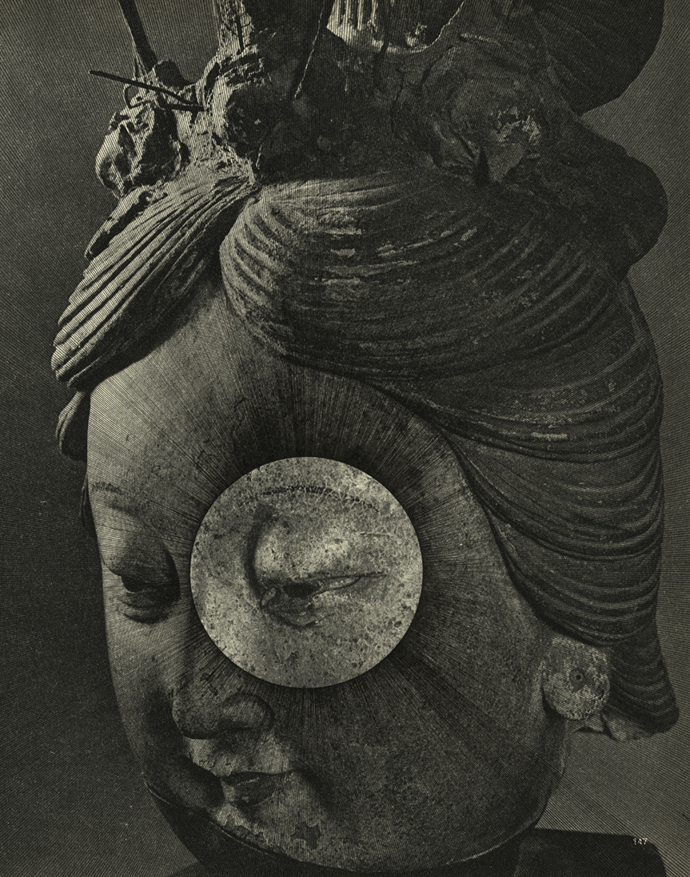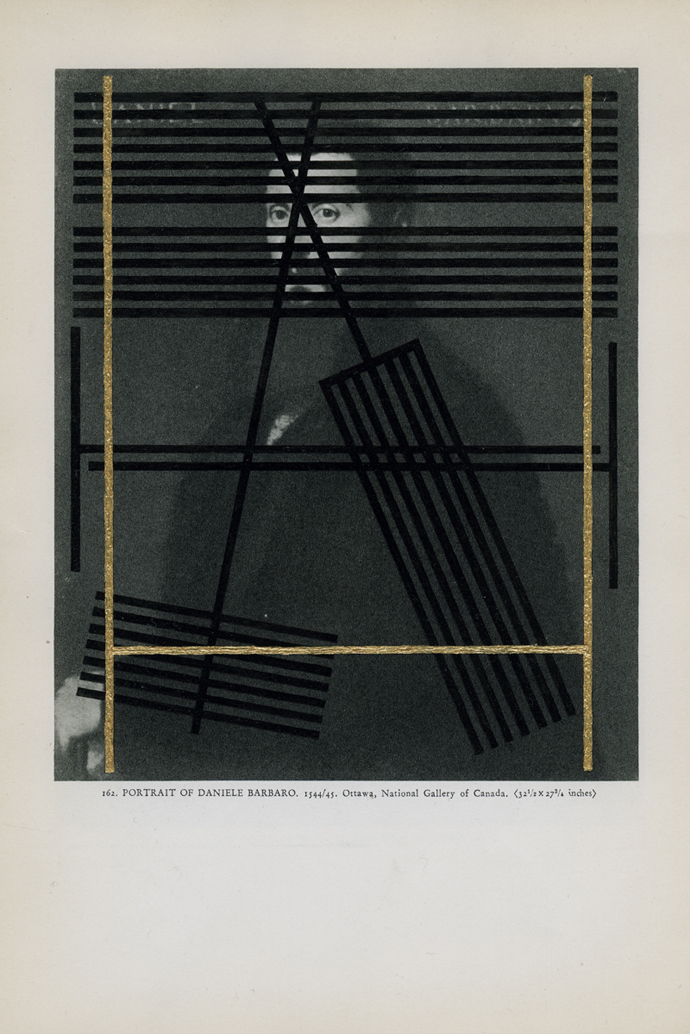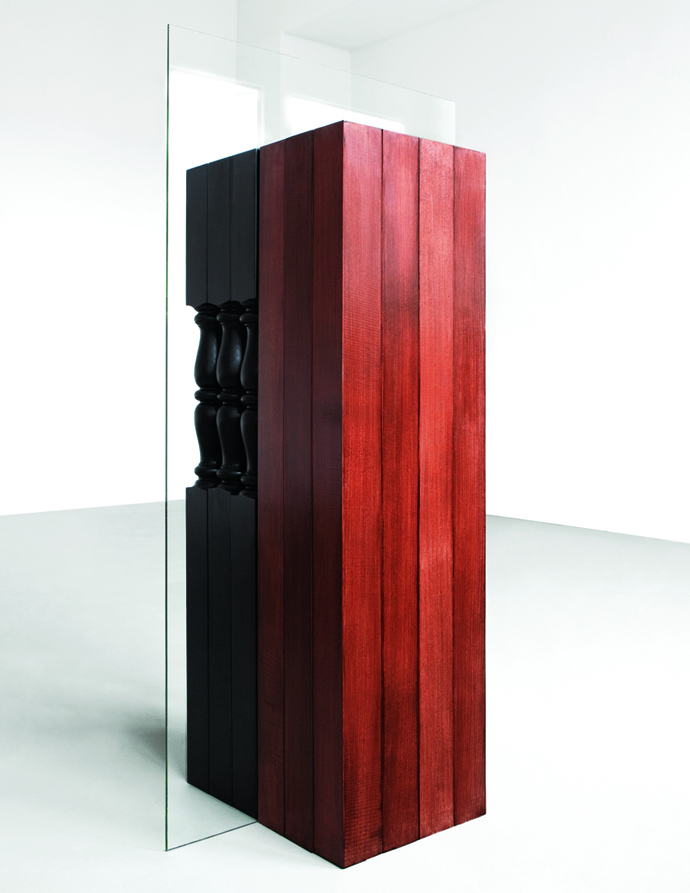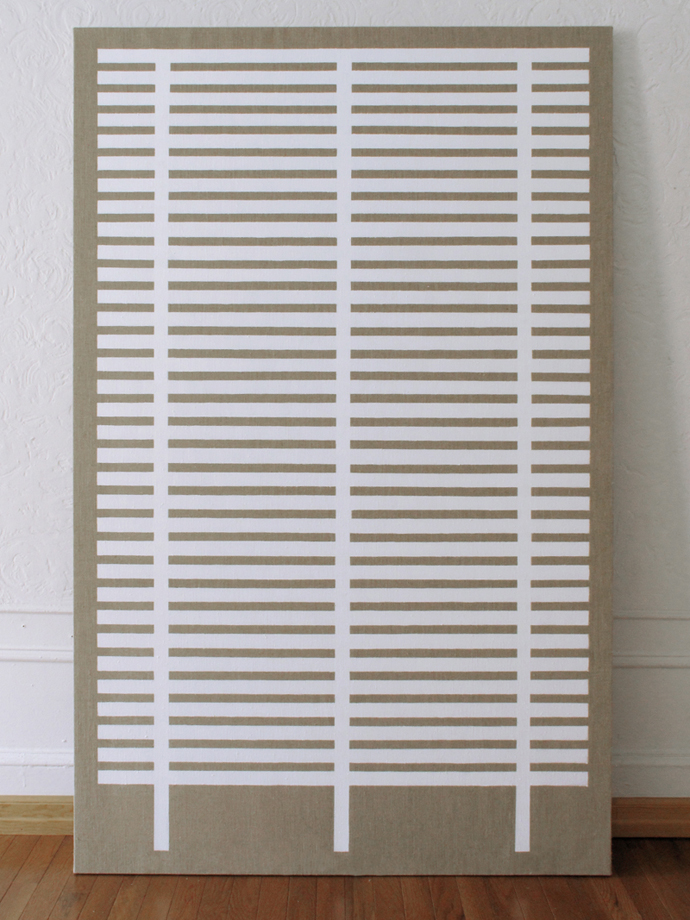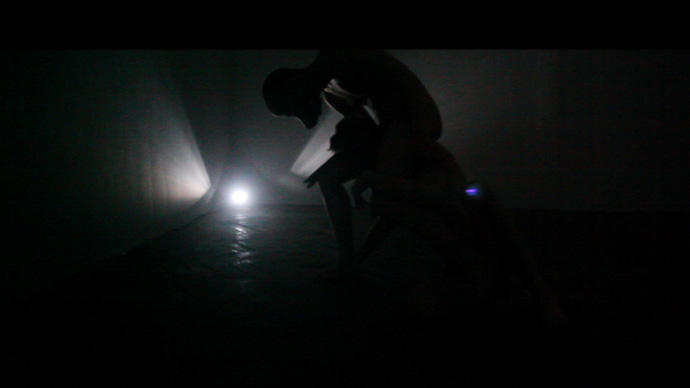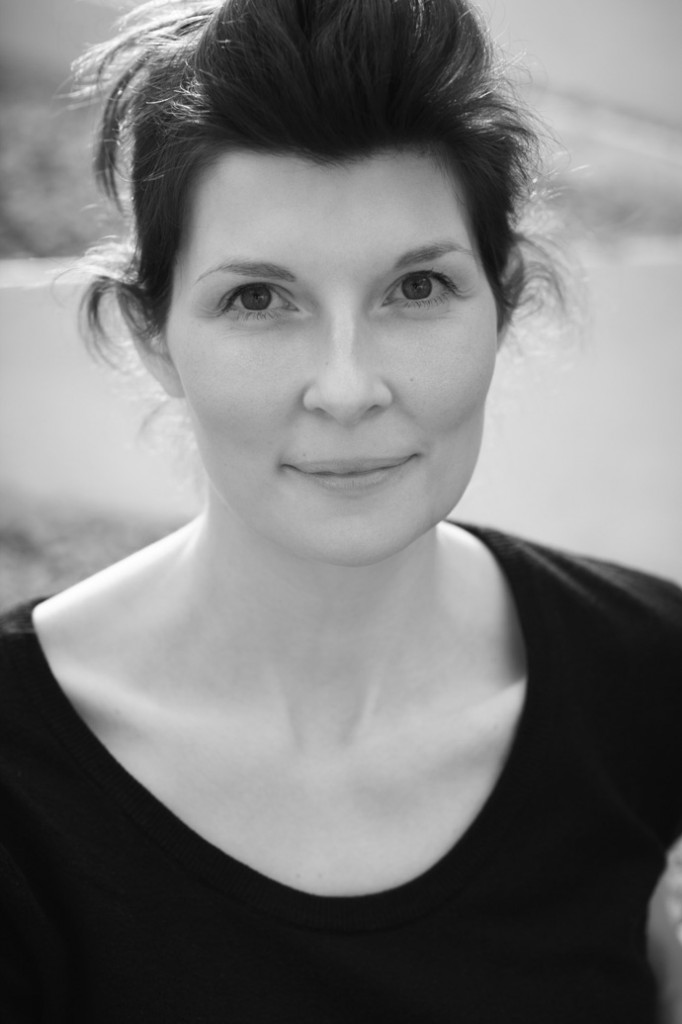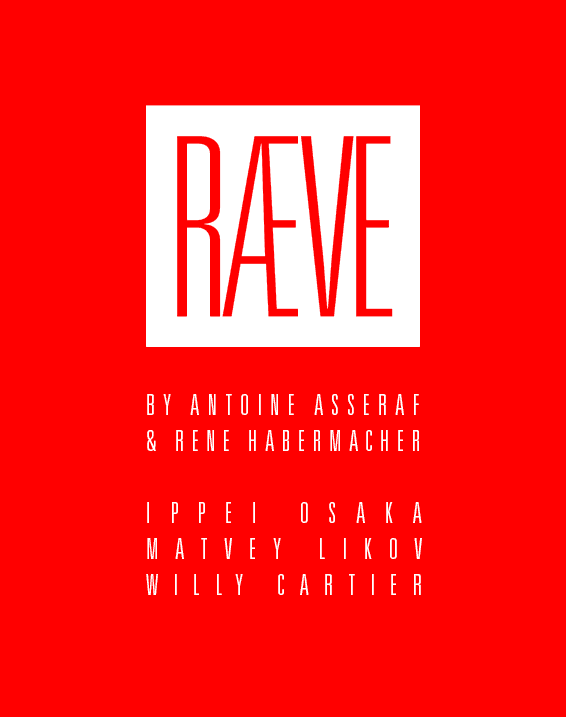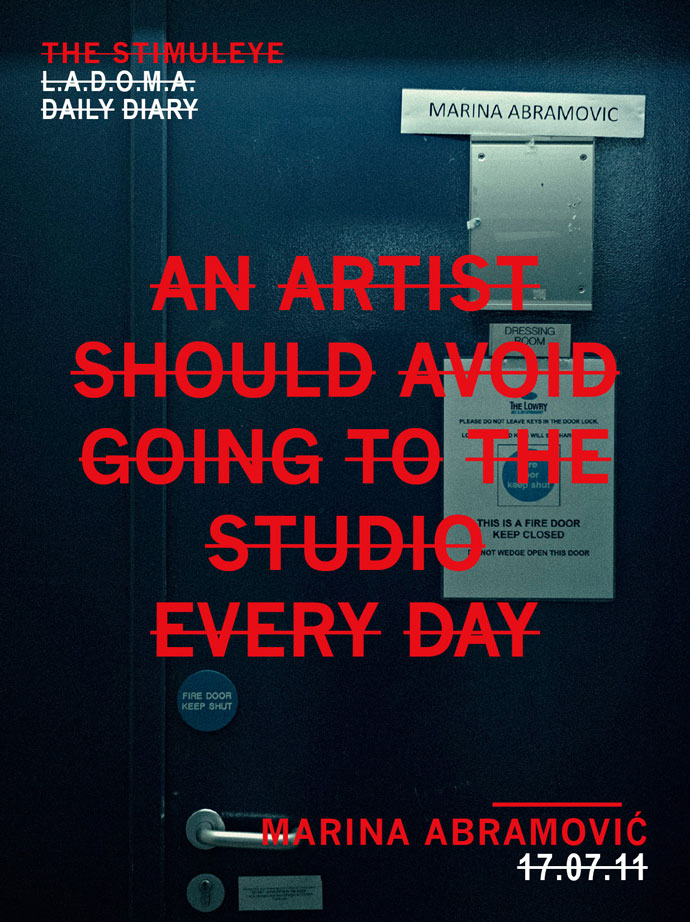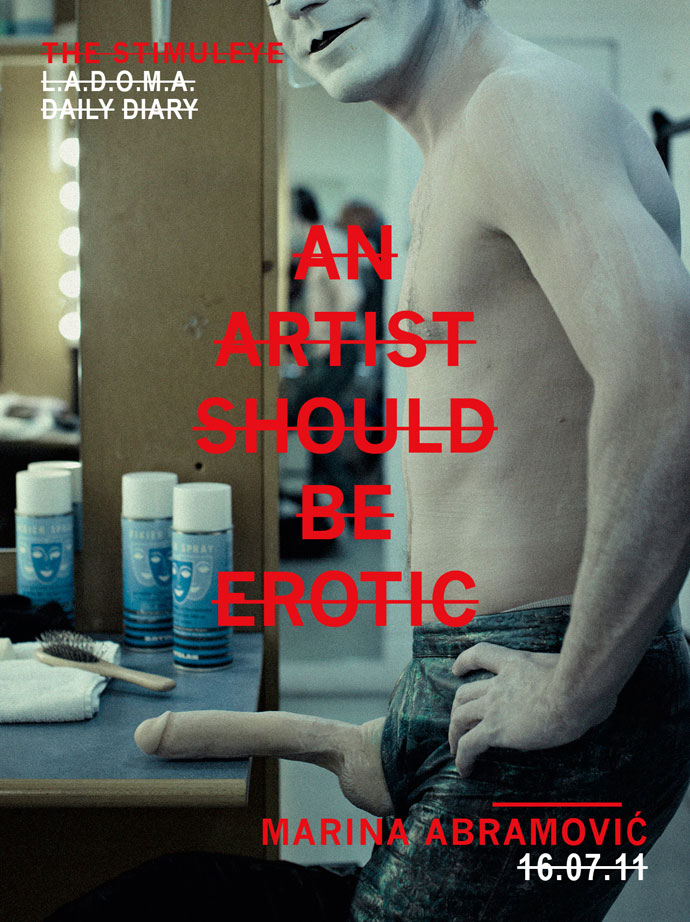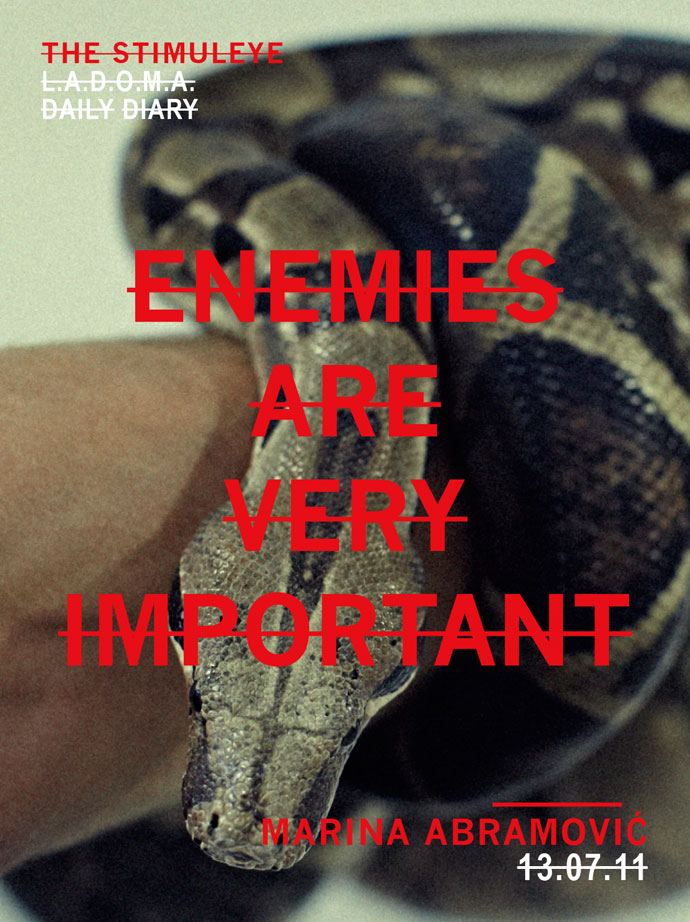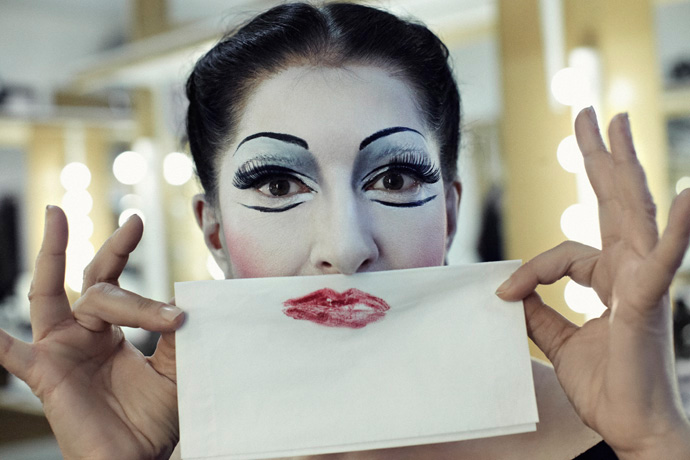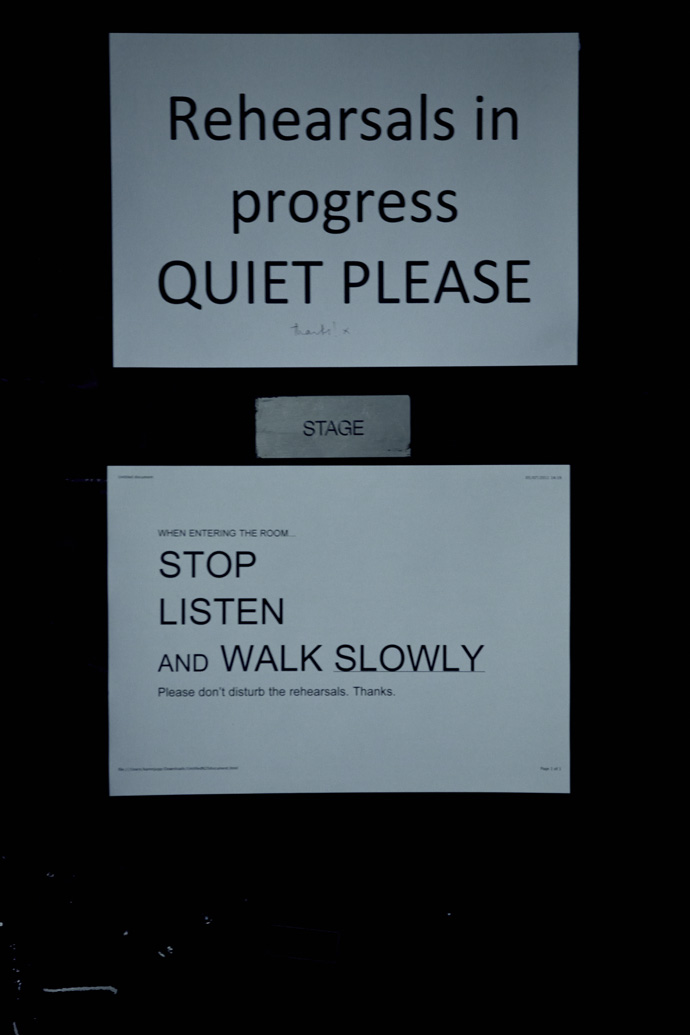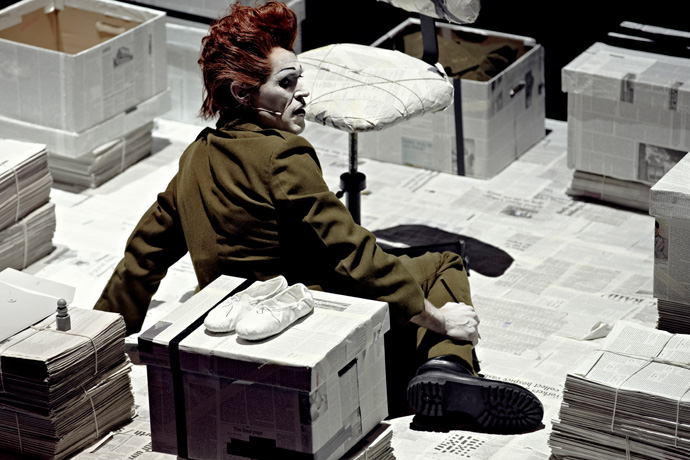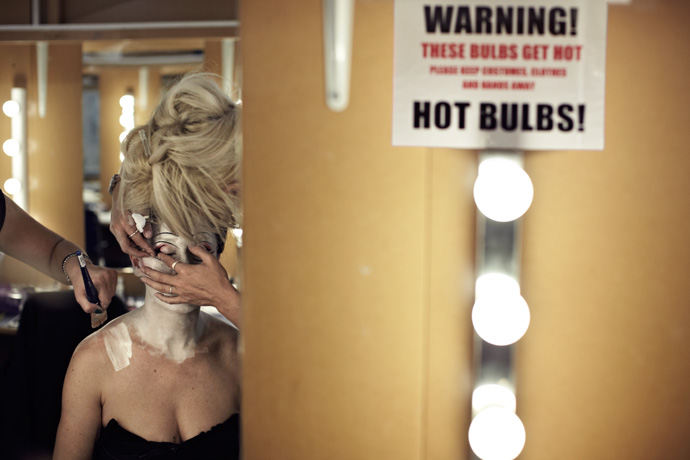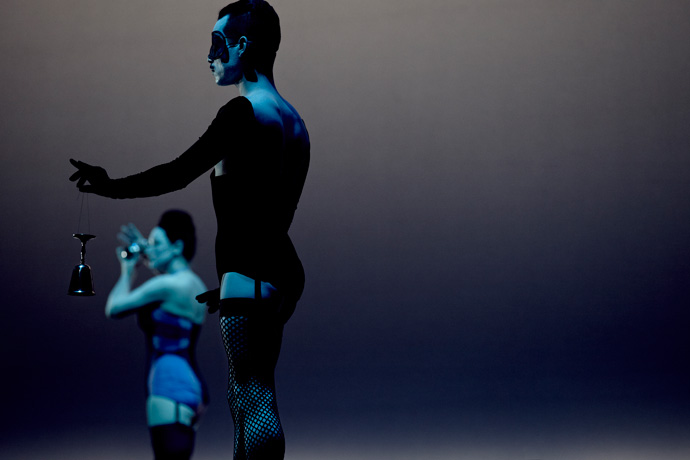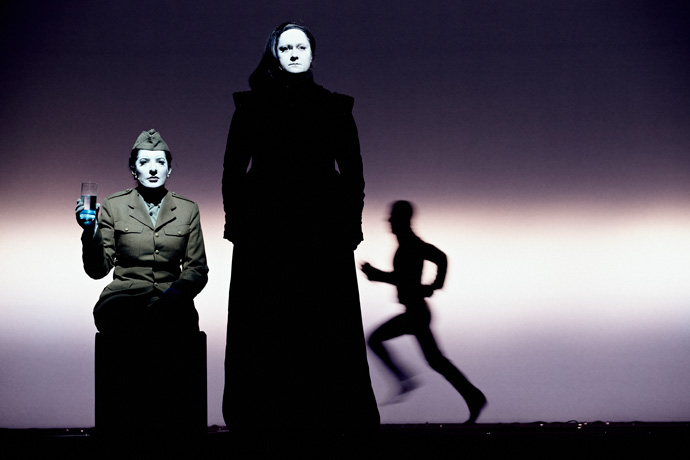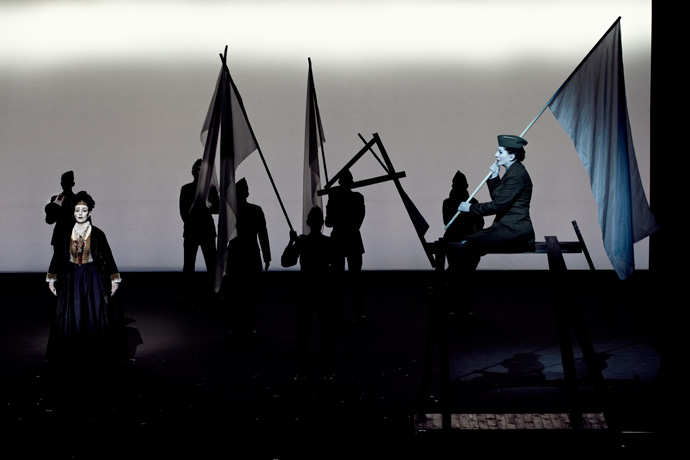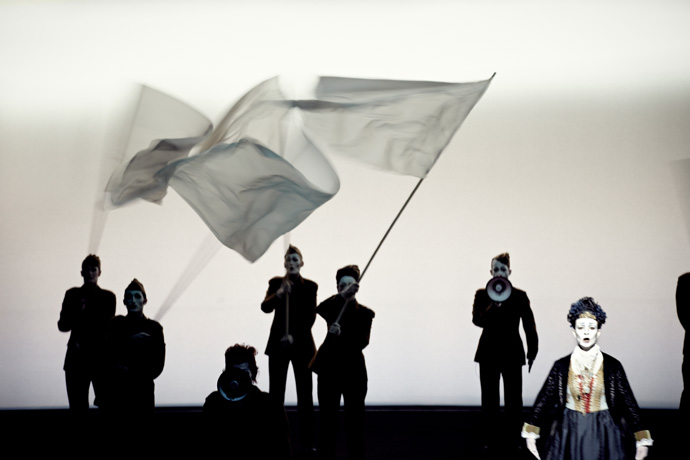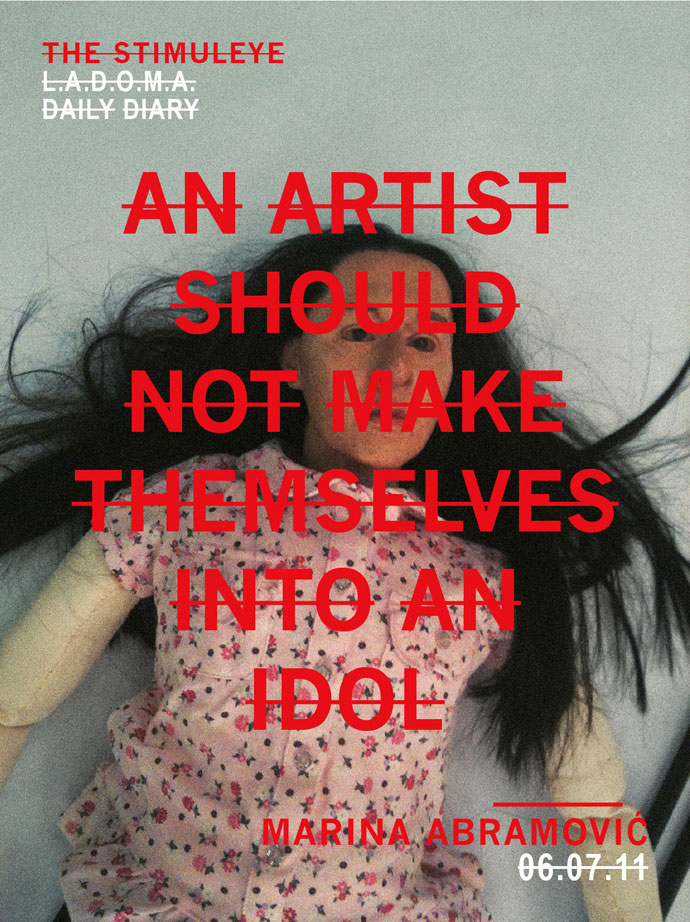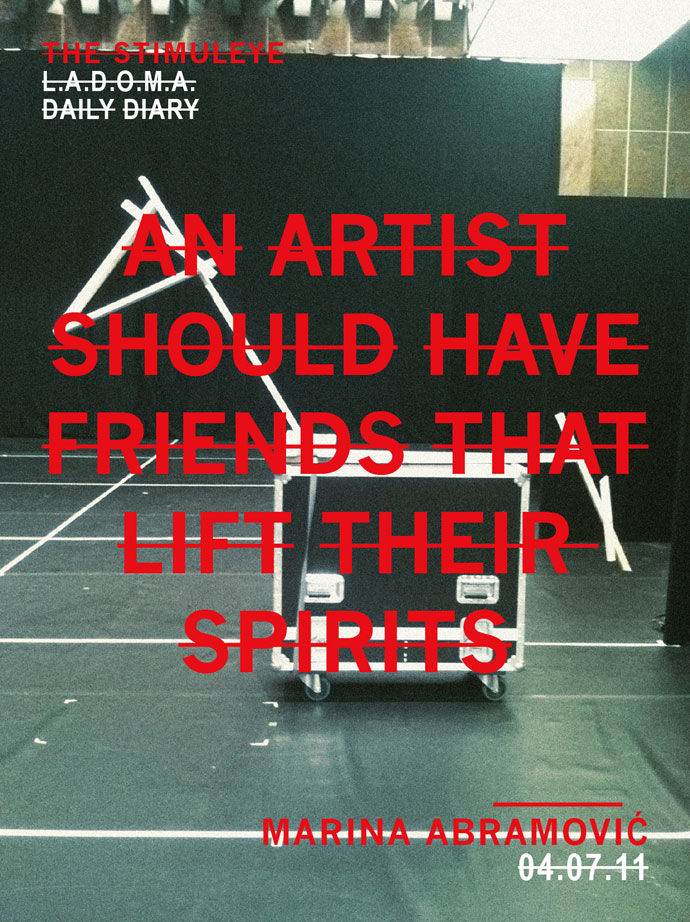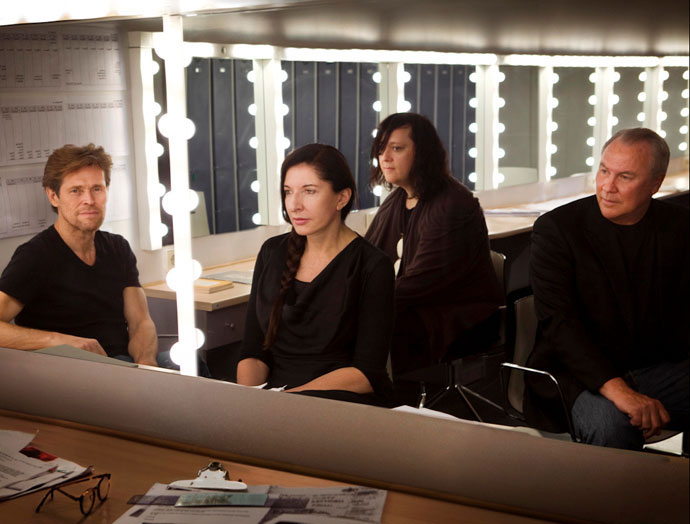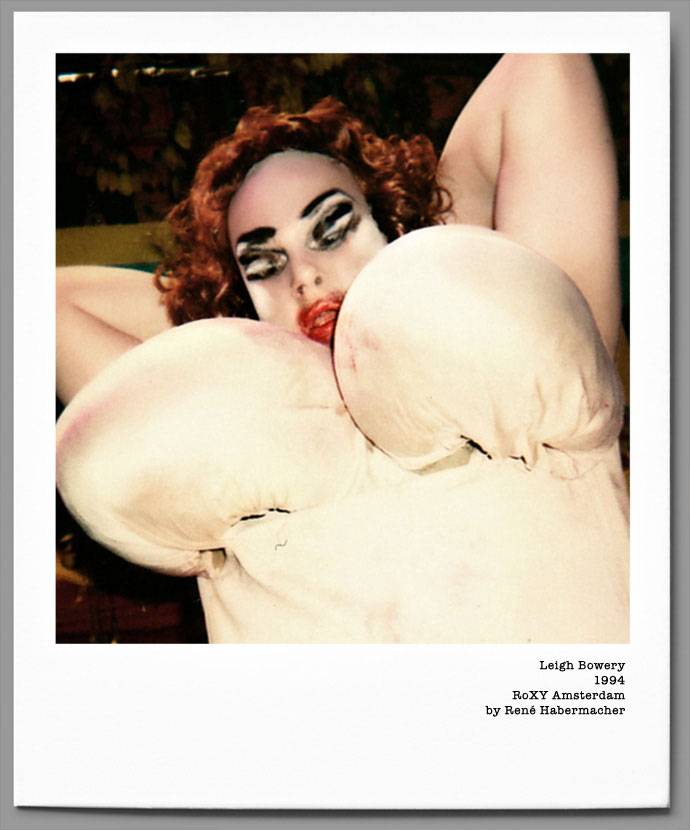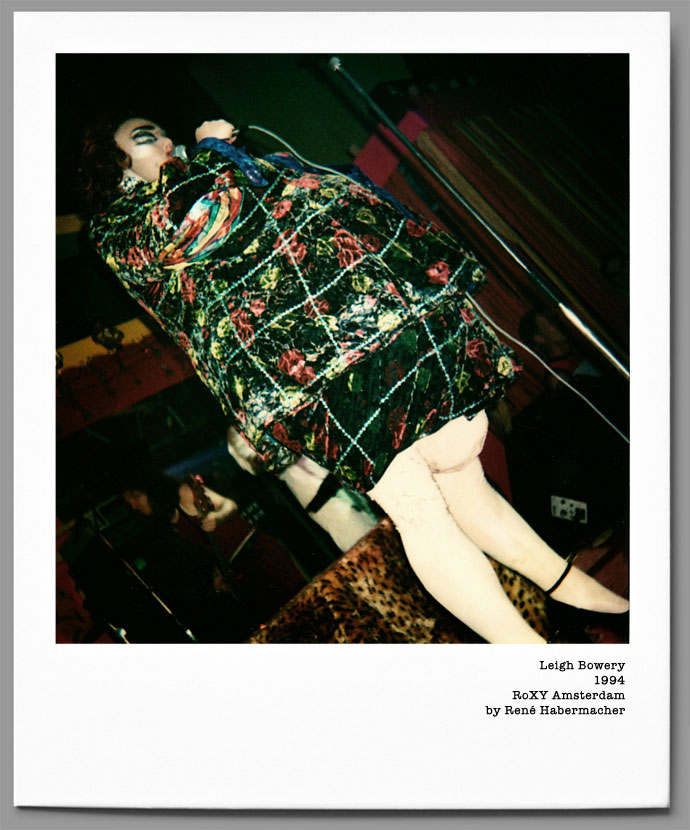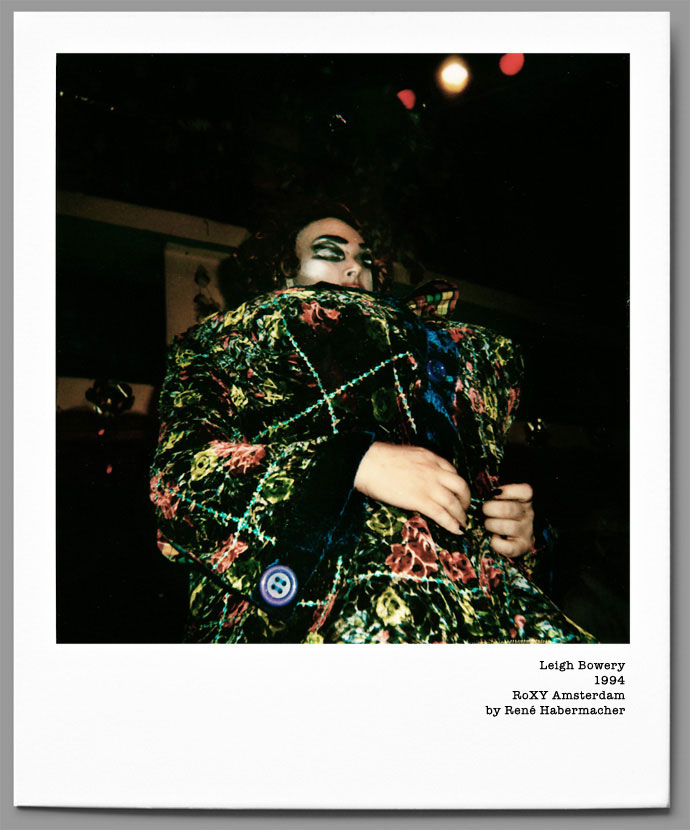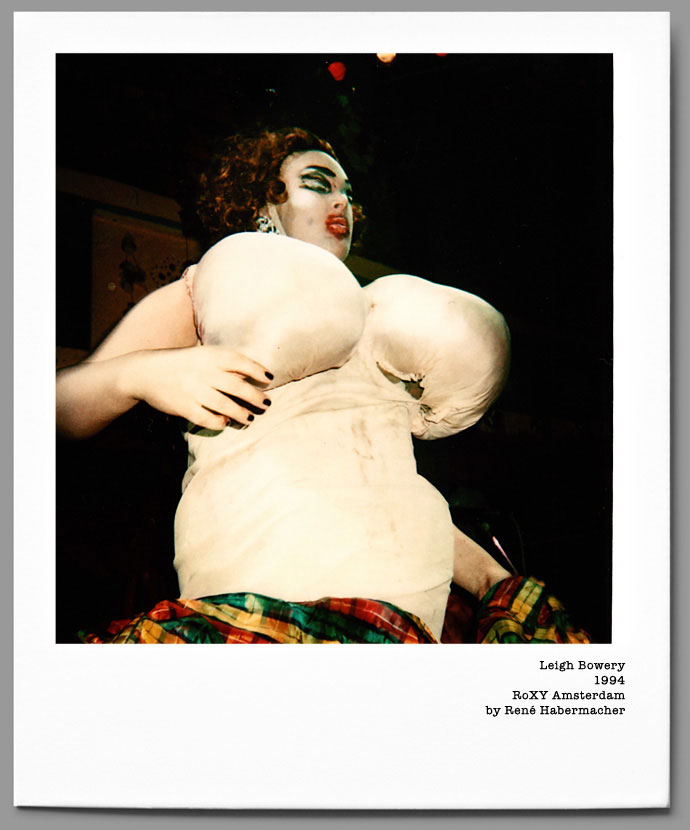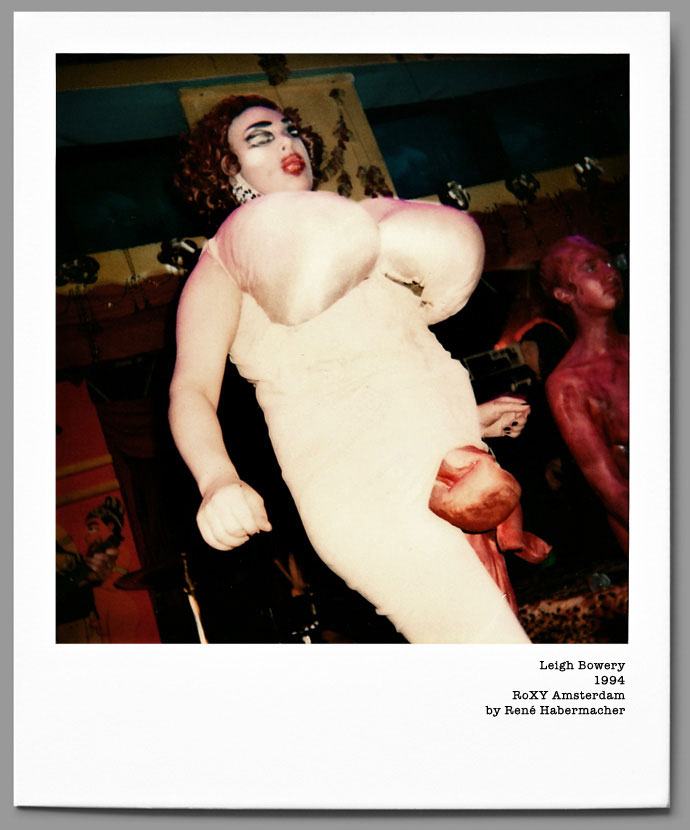-

davide balliano
-He works across many mediums, makes work and research constantly and needs to have a lot of order in his life.
New York-based Italian artist Davide Balliano had a conversation with me about his artistic trajectory, his work, rock climbing, his influences, his love of intervention and his first show in Paris at the Galerie Michel Rein.
Davide Balliano UNTITLED_Woman V Ink on book page 21x26,8 Cm 2013 Courtesy: Michel Rein Gallery, Paris
Lynsey Peisinger: Tell me a bit about your life and your path as an artist.
Davide Balliano: I was born and grew up in Torino, in the northwest of Italy. I was there until I was 18 and then I started in high school studying advertising and graphic design. It was a very peculiar school, a very specific school, which had a lot of elements that are still useful for me now. Especially the graphic design elements, the study of the image, the history of the image, art history. All of that is still informing my work today.
After that, I moved to Milan where I studied photography at Bauer, which is a fabulous school of photography. It is probably the last public school of photography that is left in Italy. What I liked of the school was the approach that they had, that I think they still have now, where rather than teaching “photography as a job”, they tried to raise us as artists working in the medium of photography. They train you as an artist who used the tool of photography. Then what you do with that tool is your choice.
Two years after school, I went to Fabrica, which is a large artist residence in Treviso, in the north east of Italy, a half hour from Venice. It is a beautiful place. A huge building built by Tadao Ando and there are usually approximately 40 artists in residence. It was very commercial-based. There is not much interest in pure artistic research. It’s more applied art. It was a very good experience–they pay you be there, they give you studio, they pay for all of your materials, they give you an apartment. You don’t have to worry about anything. But, even if it was great, it sort of crushed my relationship with photography. Fabrica had a very strong way of shaping the people that were there, so they were not making it a mystery that they couldn’t care less about the kind of photography that I was doing! I was very young, I was 21.
After Fabrica, I stayed one more year in Milano, then I got badly bored of staying in Italy. So I moved to NY in 2006. And it is in the early time in NY that I started to do other stuff. I felt that this move to NY was sort of giving me a clean cut from everything that I did until then. I sort of put photography a bit on the side and I started to draw and to intervene, but still on photographic images. I assume that because of my background in photography, I always have a difficult time starting anything from a blank background, you know from a white slate. For me, it has always been terrifying!
Davide Balliano UNTITLED_Barbaro Watercolor and acrylic on book page 18x25 Cm 2012 Courtesy: Galerie Rolando Anselmi, Berlin
LP: How did you start to move into the mediums you are working with now?
DB: So I started to print out images, mainly from the internet at that time. I still collect a lot images just for my inspiration. And I started to draw freehand on them, mainly abstract geometrical mess! Abstract scribbles, nothing with a precise meaning. Pretty soon, it sort of got clear that the issues that I had with photography were still there–even if I am intervening on top, I still had to take care very much of the meaning of the background image.
There are some images that you can just use for their mood, but there are other images that have a precise meaning that carries responsibilities. I think that this is something that you can use but you need to be conscious about it.
I always hate any kind of work in any kind of medium that just takes strong images and slams them there without standing by it. I always find that it’s a very cheap shortcut. It is something that I always hate.
So, then I started to draw on art history images because I felt that they left me more freedom somehow because there is already a big gap. You are more free to relate with the feeling of the image rather than with historical facts. The facts are there and I agree that I should deal with that, but there is a distance so there is a larger filter. So if I make a drawing on top of a portrait of a king, I should probably do research about who it is etc, but I don’t. And most people wouldn’t say “why did you make a drawing on this king and not on another one?”.
If you do the same kind of thing in photography, it is difficult because photography is such a young medium that almost any photographic image is in a historical context. So from there, the intervention grew more and more precise and became more and more essential. So if you take a drawing of four or five years ago, which was abstract and geometrical, but still messy and not so calculated, they sort of condensed somehow and at some point, it felt a need to take this intervention that I was doing on paper and put it on other mediums.
I burned that town just to see your eyes shine Wood and glass 137x48x48 Cm 2012 Courtesy: Galerie Rolando Anselmi, Berlin Photo: Nikki Brendson
LP: Tell me a bit about the medium of performance.
DB: Performance, which I do although rarely, is a different thing although I feel that it is strongly connected to….photography. It is interesting, I feel that performance is strongly connected to photography because I still feel it as the production of an image. An image that is locked by a location and by a time. I am very fascinated by the potential of making a legend with performance, not necessarily mine. Sometimes you see performances that are unrepeatable–the original work is born in one place at a specific time and if you were there, there is nothing that can repeat that moment. And it gives you something that is so unique, it sort of makes you part of the history of the work, much more than in other mediums.
Most of the time in other mediums, the work is done by an artist and then is shown. And the artwork has a life and it will be the same life for the next many many years. But a performance is in a place and in a moment and if you were there, you had the privilege of being part of it and then nothing will take that away. I find it fascinating. And I relate to it as the creation of an image, practically speaking.
LP: It sounds like performance gives you an opportunity to experience being an artist in a different way.
DB: Exactly. And also seeing what it means for other artists. It has been great because I am completely incapable of doing it in any other medium. I am sort of a control freak for anything else that I do. I know that in performance, I very much enjoy opening up to collaboration and seeing what it brings.
LP: At which point in your life did you realize that you wanted to be making art? Was it from childhood? Did you go to that graphic design school because you knew that already about yourself?
DB: Well, I will say that it depends. I always, since when I was a kid, felt an extreme need for creative expression. So I always had no doubt that I would be doing something creative in life. But, the decision to make exclusively art research sort of developed over the years. It felt like everything else just dropped and it stayed there. For all of my school time, I had the idea that it was impossible to only do that.
I always thought “I need to do something else on the side”. For example, I thought I could do graphic design while doing other work. Also with photography, but photography was even closer to making pure artwork. But it was an idealistic idea that I could be an artist but also make commercial stuff. I needed to take a decision between the two things. And I think that especially when you are young, people want one or the other.
Another thing that I understood–I sound like an old grandfather saying “when I was young…etc”! — When I was in high school I was doing a lot of rock climbing and at a certain point I had a trainer and was training five days a week. I loved it, but I liked to go out and go to concerts too. I had my social life which was very important to me. Everyone else there was like a monk about it. Just training, training, training. They ate only certain food, they were constantly on a diet. Complete dedication. I understood that I couldn’t at all put in that type of dedication and I couldn’t compete with people that were that dedicated to it. And later, I felt the same way with photography.
If you are trying to do something good, you should consider that most likely there is somebody else that is trying to do it and he is going to be very good at it and he is going to put all his energy into it, he is going to make tons of sacrifices and he is going to go through hell to achieve it. So if you are not up for that, you are in for a competition that will never bring you anywhere. So photography for me was sort of like that.
I was in Milano therefore everything was about fashion photography. I mean, fashion photography was fun! I would go to a set, with models and people and music. It’s all fun. But if you are trying to do it, you are in competition with 500 kids obsessed with their freaking portfolios who are putting their money into making fashion photography. I’m like “hell no”! I have to be paid to make fashion photography, not the other way around. People would tell me that I had to put together a fashion photography portfolio and then when people look at you because of that, you bring in your art research. But for me, I knew I would not have the energy to do that because I was already putting all my energy into my research. And I sort of became clear that it wouldn’t work. I had to push on thing or the other.
So I decided only to concentrate on art. I assisted for many years. I wanted to learn from an artist. I wanted to learn about art-making and also the practical side of it.
Davide Balliano UNTITLED_Grid27 Acrylic on linen 120x180 Cm 2012
LP: When you came to NY, you assisted Marina Abramovic for four years. How did that experience influence your work and how did it prepare you for your own path as an artist?
DB: For me, Marina was like my own private university. She taught me everything that I know about surviving as an artist.
Independently of the love that I have of her work–I approached her because I always had an extreme fascination with her work– the privilege that I had when working with her was that I was in contact with the private side of her. And what I gained from the private relationship is to see how she is completely dedicated to her work. Marina is all work. And there is an insane amount of energy and dedication that she puts into it. Her work is her life, there is no separation, there is no in between.
The personal investment that she makes in her work, I assume gives her this concentration that comes out so clearly in the work. And, other than that, she is such a big artists that if you work with her for four years, afterwards you can truly do anything. I came out of that experience being practically scared of nothing.
Marina works at such a level of intensity that there is really nothing that you can’t do after that. It is like boot camp. You are so used to working under pressure –good pressure, but pressure–daily. Everyday was the same amount of concentration and speed and pressure. The responsibilities are always big. There is never a day that you go and pick up flowers! Every day is something big, something important, something that you can’t mess up. When you do that every day for four years, you come out and truly its like those American movies about Marines. You can really do anything!
LP: You seem to have an approach to your work that is extremely organized and structured. It seems to me that are an artist who approaches your work like one might approach any business in terms of how you structure and use your time and also how you interact with and deal with people. I wonder if working with Marina influenced that or if you were always someone who could self-motivate and give order to your life.
DB: Definitely working with Marina, and my other assistant jobs, gave me that structure. Marina is naturally 80 percent of it, but everything contributed. Assisting fashion photographers meant being efficient and fast. There are a lot of responsibilities and you have to work under pressure, so you get used to needing to maintain focus. Keeping your concentration on the work itself under all the pressure seems to me to be the secret that all of these big guys shared.
There are tons of different kinds of artists and I know fabulous artists that work in complete chaos and it’s fine for them. Their art can come out of that. They can do nothing for weeks and then disappear and work day and night for a month and then come out like drained zombies, but the resulting work is marvelous.
But that’s not for me. The less I do, the more in pain I feel.
Davide Balliano PICATRIX, installation view Courtesy: Michel Rein Gallery, Paris
LP: Tell me about that show in Paris.
DB: The show in Paris started with an invitation from Eugenio Viola, a wonderful curator that I worked with last January. He invited me to have this little show and he set the theme of the show. He asked me to work with the concepts of alchemy and symbolism and sort of esoteric feelings, which is something that is present in my work even if I don’t always relate to those things in my life.
There are four works on paper, two paintings on board and one sculpture. We see a combination of different mediums and the dialogue that they have with each other, which is very important for me. I never make a show that deals with only one medium because it feels like a small part of what I do. I feel like I can’t say what I want to say with one medium, I have to put them together.
In the past Alchemy was called “the great work” and I love it. I like the utopic idea that through my work, and the elements given to me, I can control these elements and have a higher understanding of who I am and a higher consciousness.
Eugenio asked me to consider these things and to put together a little show that gives my view on these topics, so I did.
LP: What is the last thing that stimulated you?
DB: The film The Turin Horse by Bela Tarr. It is really stuck in my mind and I keep on thinking about it. It was very very strong for me. And not because I am from Turin! Its strict and minimal and powerful and its a complete tragedy. There is no space for hope, no space for light, like a classic tragedy. Everything is rotting and closing in on you. Sometimes I feel that tragedy might be more inspiring than happy thoughts. Happy thoughts are private while tragedy can be shared and if you recognize the suffering in someone else, it can make you feel less alone in your own troubles. That is probably why all of the work that I strongly admire has a heavy portion of tragedy and weight.
PICATRIX at Galerie Michel Rein, curated by Eugenio Viola
http://michelrein.com/
http://www.davideballiano.com/00 -

Olivier Saillard, Violetta Sanchez, and 25 ways to be a turncoat
-“We nominate McQueen at Mugler and Armani Casa at Margiela…
We nominate Margiela at Schiaparelli and order him not to make any collections to preserve the surrealist spirit of the house.”

Curator Olivier Saillard hosted another one of his legend-in-the-making performances during couture week, this time in the intimate setting of the APC headquarters.
For 30 minutes, Saillard and his collaborator Violetta Sanchez pushed the classic man’s grey blazer to the limit (and beyond) by showing 25 ways it could be worn, while reciting a surreal list of nominations that read like a “who’s who” and a “what’s-wrong” with today’s fashion scene.
Can’t wait to see what Saillard comes up with next.
-

The perfect muse: François Sagat
-In Carlo Collodi’s 1883 children’s novel “The Adventures of Pinocchio” it is the wooden puppet that possesses sentience prior to its transformation; it is the puppet and not its creator, the woodcarver who triggers the miracle of the doll coming alive.
With François one never knows who pulls the strings. It is him who invokes the sentiment for a story to become alive. Yet he hands himself over unconditionally to his collaborators, like an “instrument to be played”, as he likes to call it.
Film director Christopher Honoré once expressed that François Sagat “redefines the notion of masculinity”. François, the humble boy from Cognac has moulded himself to unattainable iconic status. Gilded with his blue inked crane, he is to conquer his righteous spot in the pantheon of pop culture…
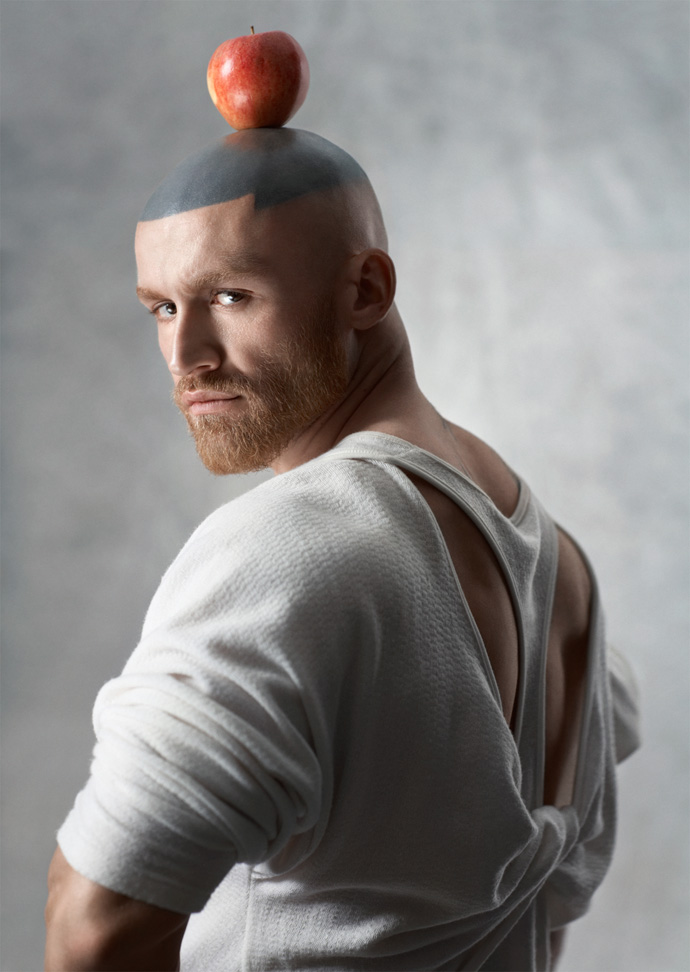 "François Sagat with Apple" Exhibition SPECTRE, Hyères 2010. Photography by René Habermacher
"François Sagat with Apple" Exhibition SPECTRE, Hyères 2010. Photography by René HabermacherRené Habermacher : you recently played alongside Chiara Mastroianni in HOMME AU BAIN by Christophe Honoré, and as well the lead in Bruce LaBruce L.A. ZOMBIE – how were your experiences?
François Sagat: L.A ZOMBIE was an experience which had very little to do with HOMME AU BAIN… The shoot for LA ZOMBIE was like a real porno shoot, scene by scene, it was mostly fucking, except that of course the porno version was censored for festivals…Beyond the sex scenes, LA ZOMBIE was a chaotic shoot, without a script, hasardous… but I’m still to this day satisfied with this participation and collaboration with Bruce LaBruce, from whom I still have much to learn, and who possesses a huge cinema and litterary culture… Despite what his critics say, I think Bruce has a real style.
During the shoot I really tested my capacity to resist “obstacles”, it was at times very difficult, I didn’t know where I was going, no direction, it was like being thrown in the lion’s den.
There was no script, the storytelling was weak and the whole plan was turned on its head by last minute changes and many cancelations, but that can be said about a lot of “cinema” projects.L'HOMME AU BAIN by Christophe Honoré, starring Chiara Mastroianni and François Sagat.
Regarding HOMME AU BAIN, the shooting was a lot more structured, but energetic nevertheless. It’s on this project that I realized that my abilities as an actor were limited, weak even, and felt like I was a big challenge for Christophe Honoré because of my “heavy” image, of the luggage I was carrying.
There were moments when I thought I terrified him, being everything except malleable. The project was constantly evolving due to the fact that we had planned it as a short, and that a lot of questions arose towards the end of shooting. It was finally released as a full feature film, and I have the feeling it wasn’t the right place for the film.It was an intimate project which to me, with hindsight, would have had a strong impact as a short. But I am neither director nor the creator of my own character. Rather than control the situation, I felt the blowback. But surely the imperfection of the final result makes it a real film, that can be remarked and criticized. I chose to shoot it and live the collaboration for the moment rather than think of the finished product.
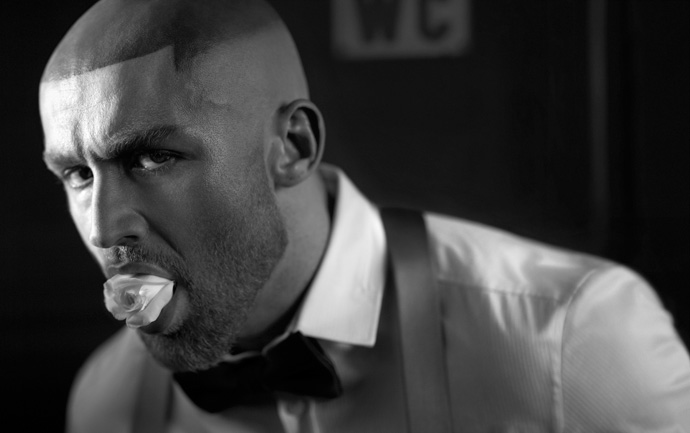 François Sagat for QVEST magazine. Photography by René Habermacher.
François Sagat for QVEST magazine. Photography by René Habermacher.What is the difference to you between acting in a porn movie or a feature film?
The difference ? Of course there are differences.
When you’re a porno actor, you’re in constant control of your carnal envelope and your physical aspect, whether you learn it or you have it from the start.
I didn’t know it as first but I am someone who has that ability. Porn is often an activity for people who are shy orally.
As a performer, you never really have to carry the more or less artistic responsabilities of a porn film, because there is no artistic issue to start with. You just have to be a good soldier fitting what the consumer desires to watch and what the production has decided, and that’s it.
I think also that I am someone who’s very sexual and exhibitiionist, but that’s not really giving you a scoop. Porn is like military service, it’s “my way or the highway”, and in my case, I’ve been and continue to be a good soldier.
The main difference is that you need a capacity to adapt and to lose who you really are, physically as well as morally. I created for myself a character in porn as in life, it’s difficult to let it go.
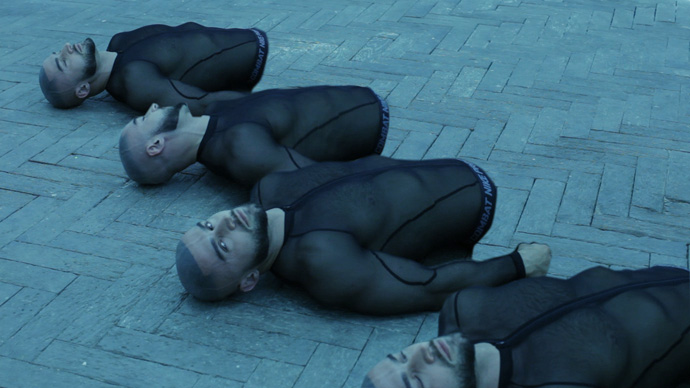 Video still from PILORI installation by Lynsey Peisinger & The Stimuleye. Villa Noailles, Hyères 2012.
Video still from PILORI installation by Lynsey Peisinger & The Stimuleye. Villa Noailles, Hyères 2012. -

pilori, beyond the wall & simone fehlinger
-If you didn’t make it for the 3 days of the Hyères Fashion & Photography Festival, you still have until May 26, 2012 to see the exhibitions of the festival at the Villa Noailles in town, including Yohji Yamamoto, Jason Evans, Anouk Kruithof, Ina Jang, Cunningston & Sanderson, Chronique Curiosité, Inez & Vinoodh and… Lynsey Peisinger + The Stimuleye’s performance/installation/video hybrid, PILORI.
Until the end of May you can see at the villa the PILORI installation featuring footage of the performance (with the cooperation of Yohji Yamamoto Inc.) and video contributions by Antoine Asseraf & René Habermacher, starring François Sagat, by Jason Last & Jaime Rubiano, Clément Roncier, Sebastien Meunier + Romain Dja Douadji + Tomek Jarolim, and the winner of our internet contest, Simone Fehlinger, who met up with Filep Motwary.
PILORI (“PILLORY”) is a unique collaboration between choreographer Lynsey Peisinger and The Stimuleye for the Hyères Festival. Drawing on a pool of both local and Paris-based performers, Lynsey Peisinger conceived 2-hour performances inside a specially built space in the Villa Noailles’ Sautoir space: a wall with 4 pairs of legs poking out, moving, at rest, ignoring or harassing each other…
For its exhibition phase, the performance footage is augmented and interrupted by the footage of BEYOND THE WALL, different video artists’ renderings of what lies beyond the wall which cuts the performers in half.
CLONES starring François Sagat, by Antoine Asseraf & René Habermacher.
Sebastien Meunier, Romain Dja Douadji & Tomek Jarolim for BEYOND THE WALL.
Clément Roncier for BEYOND THE WALL/PILORI.
Jason Last & Jaime Rubiano for BEYOND THE WALL/PILORI.
Simone Fehlinger for BEYOND THE WALL / PILORI.
Filep Motwary: What is your video about?
Simone Fehlinger: my videos visualize the stories of walls. Parts of these walls are broken : colors, wallpapers peel off and uncover it’s past… The videos invite to a personal imagination of what this wall’s history is about… Now, these walls have moved to Hyères 2012 and will be part of a new story…Filep Motwary: Why have you chosen white as your “backwards” canvas?
Surfaces are extremely exciting ! But the interesting part is not the perfectly clean, virgin, new, white layer.
It’s the layer underneath…What is your opinion about Hyeres.
It’s legendary ! I’m really happy and honoured to be a part of…What would be your next projects about?
My new big project is my own graphic and video design studio in Paris.Simone Fehlinger, winner of BEYOND THE WALL contest.
PILORI at Villa Noailles
Until May 26, 2012
Hyères, FRANCE.Special thanks to Coralie Gaultier & the Yohji Yamamoto Inc team,
Simone Fehlinger for her contribution,
and all the performers who gave their time to participate in this project. -

contest: beyond the wall
-For the 27th edition of the Hyères Fashion + Photo Festival, The Stimuleye presents choreographer Lynsey Peisinger’s PILLORY, a performance/video/installation hybrid.
Submit your 30 seconds maximum video before April 1st for a chance to have it featured in the installation, which launches April 27th at the 2012 Hyères Fashion + Photo Festival, next exhibits by Yohji Yamamoto, Jasons Evans, and Inez van Laamswerde + Vinoodh Matadin.
Imagine what lies beyond the wall of the PILLORY installation.
All submitted videos must be
no more than 30 seconds long,
from one angle/point of view,
and submitted before April 1st, 2012.Fore more info and video guidelines: contest@thestimuleye.com
-

must see: guy maddin’s spiritismes
-Damned movies, cinema legends, performance, a trance…
Guy Maddin’s new project at Centre Pompidou, featuring Ariane Labed and other stars such as Mathieu Amalric, Amira Casar, Udo Kier and Charlotte Rampling, has all the right ingredients, and best of all, is open for all to see.
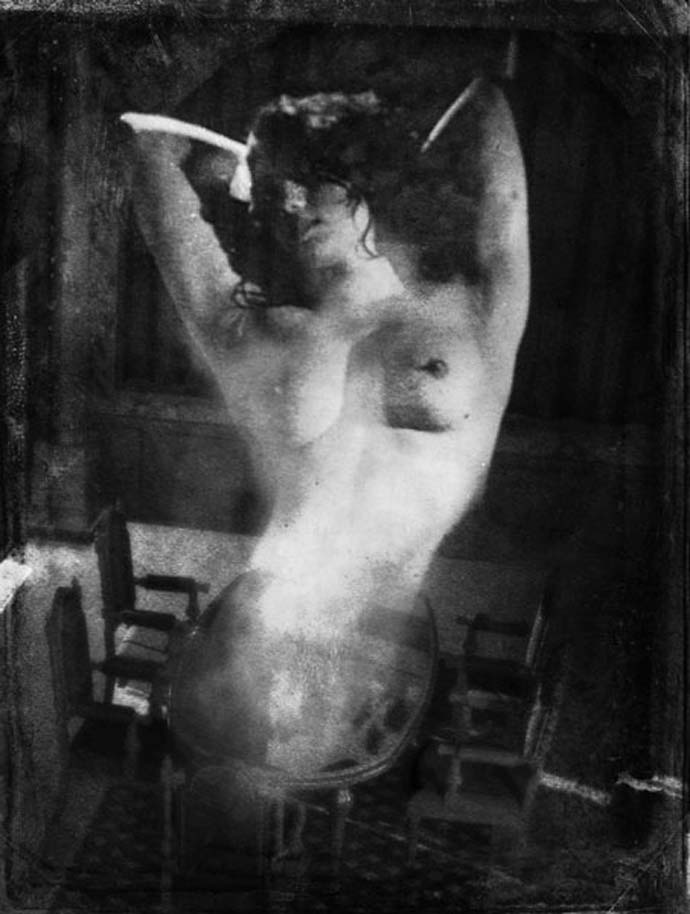 Collage by Galen Johnson for SPIRITISMES.
Collage by Galen Johnson for SPIRITISMES.Cult Canadian film-maker Guy Maddin invites anyone in Paris or with an internet connection to follow him and his actors live as they meditate and then shoot lost, unreleased or unfinished films by the likes of Hitchcock and Eric von Stroheim…
More info on the Pompidou Center website.
Follow the shoot live with 3 cameras on the Nouveau Festival / Spiritismes website.
-

An artist should not make himself into an idol
-Marina Abramović is everywhere lately.
A marathon performance at MoMa, another retrospective in Moscow, on the cover of POP magazine, hosting a star studded event at Jeffrey Deitch’s MOCA in LA and an exhibition at The Serpentine Gallery slated for 2012, the HBO documentary “The Artist is Present” just screened at Sundance. An ever growing list of projects that is taking her across continents…
Exclusive long form of interview first published in POP magazine FW2012
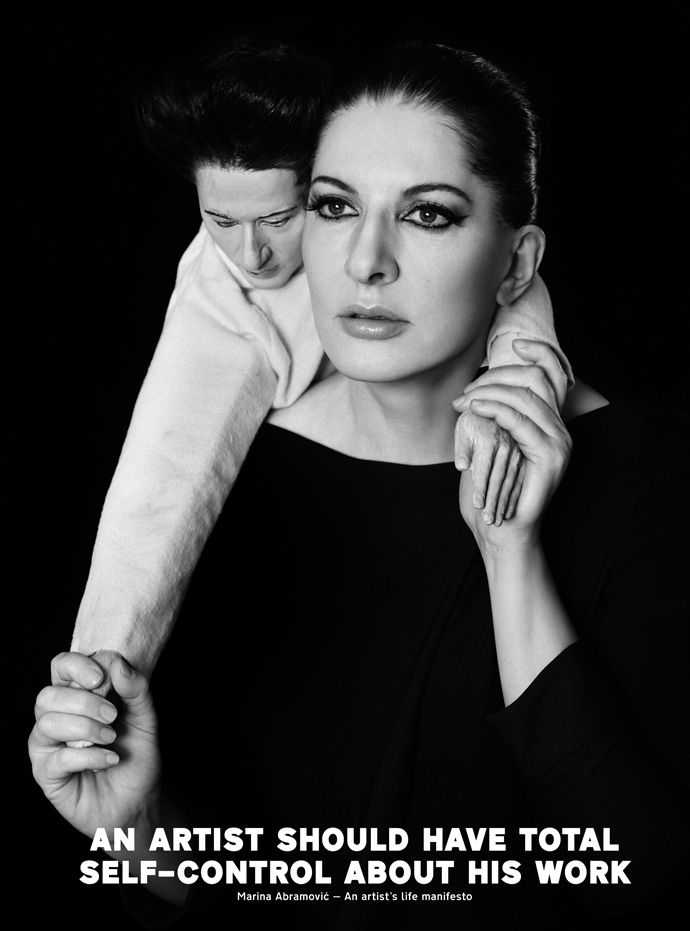 Marina Abramović with her "Mini Me". Photography by René Habermacher for POP magazine
Marina Abramović with her "Mini Me". Photography by René Habermacher for POP magazine
Marina Abramović is everywhere lately. She has emerged from what was considered an alternative section of contemporary art, Performance Art, to finally occupy an untouchable position in the Pantheon of Pop.
A marathon performance at the MoMa, another retrospective in Moscow scheduled, and an exhibition at The Serpentine Gallery slated for 2012, day and night filming of an HBO documentary and an ever growing list of projects. Marina is known for her works in which she tests and pushes her emotional,mental and physical strength, but her schedule takes its toll: Marina is exhausted.
Broad recognition has come comparably late for Abramović, who was often categorized as some sort of Exotic Serbian Vixen. Nevertheless, she has shaped a significant slice of art history like no other.
Today, less considered for her public sexual identity, and more appreciated for her timelessness and her bravery, one could unarguably call Marina “the diva of contemporary art”, were she not so grounded.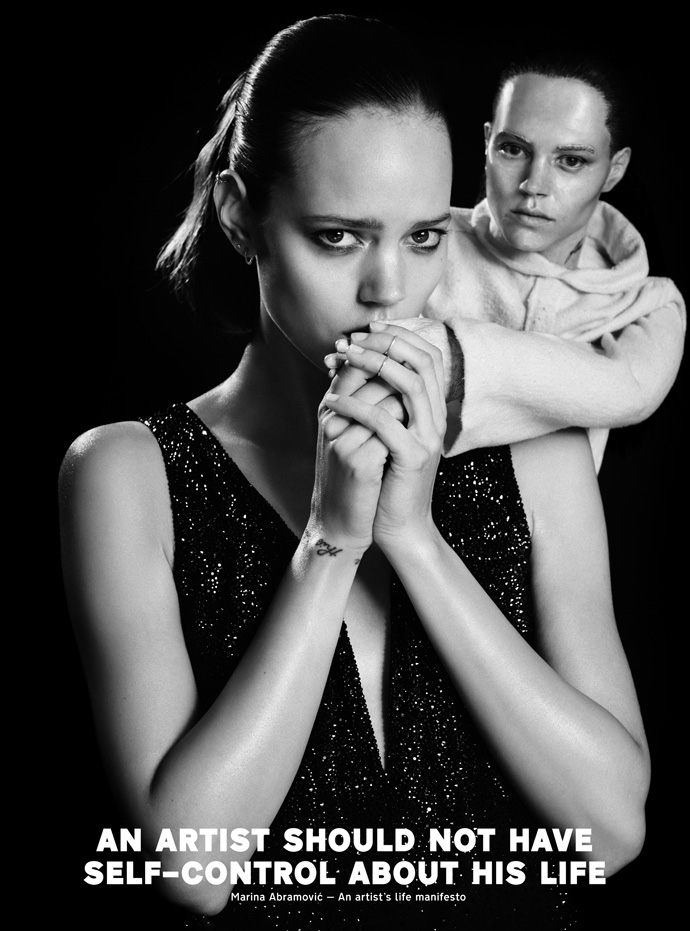 Freja Beha Erichsen with her "Mini Me". A collaboration by Marina Abramović for POP magazine
Photography by René Habermacher
Freja Beha Erichsen with her "Mini Me". A collaboration by Marina Abramović for POP magazine
Photography by René HabermacherOur conversation takes place just after Marina’s return to New York from Manchester, England where she spent six weeks collaborating with Robert Wilson on a new biography, “The Life and Death of Marina Abramović”. The play was staged with accompanied music written and conducted by Antony (of Antony and the Johnsons) and narrated by a ferocious Willem Dafoe.
The audience witnessed him meticulously rummaging through the details of her life chronologically. Marina has been clear about her lack of appreciation for theatre as a concept and this play marks a sharp departure from her concept of herself as a performance artist.She participates in what she used to essentially despise: “To be a performance artist, you have to hate theatre. Theatre is fake: there is a black box, you pay for a ticket, and you sit in the dark and see somebody playing somebody else’s life. The knife is not real, the blood is not real, and the emotions are not real. Performance is just the opposite: the knife is real, the blood is real, and the emotions are real. It’s a very different concept. It’s about true reality.”
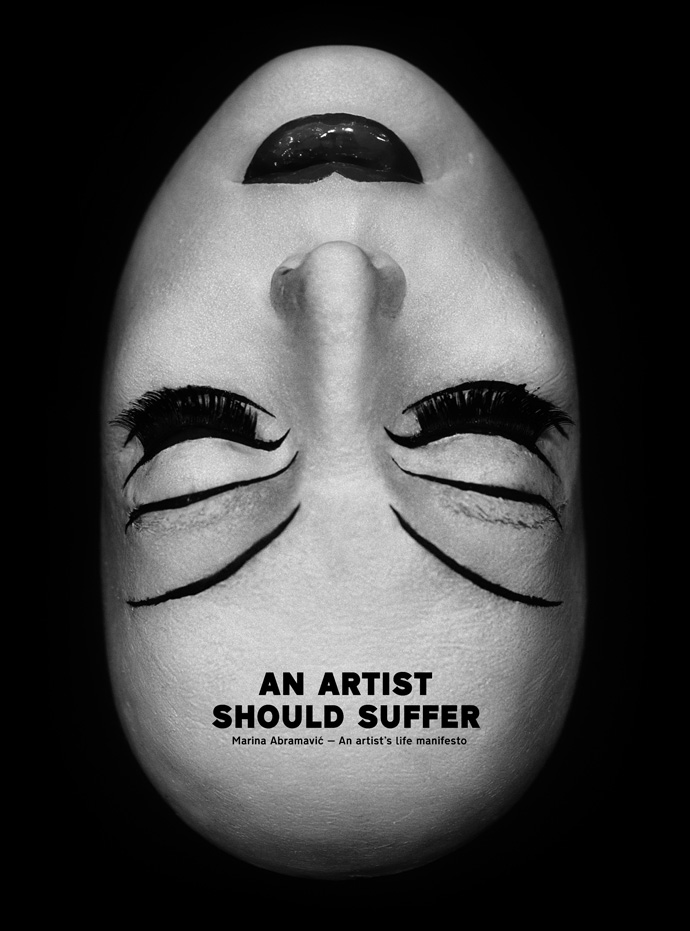 Death mask of Marina Abramović. Photography by René Habermacher
Death mask of Marina Abramović. Photography by René HabermacherRené Habermacher: With this piece you staged something that you call artificial theatre. It lacks the realness that is central to your work. How was this experience for you?
Marina Abramović: I am his material. I completely gave all the control to Bob (Robert Wilson). That is the only way to really be material for someone else, which is very interesting, because its just absolutely the opposite of what I do. This is first time that i have this really radical approach with Bob – he absolutely refused anything to do with performance. This was an amazing experience for me and very difficult, because his approach to rehearsal is like mine to performance, – but yet it’s just rehearsal! Just be there for hours and hours in order for him to fix the light. I lose my reason, I need the public, I need another kind of dialogue. This was a huge discipline not to kill him!
RH: How did this project with Bob come together? (more…)
-

not lost : ræve
-Once upon a time, we made a fashion film shoot with some of the best men’s designs around.
Givenchy, Raf Simons, Ann Demeulemeester, Rick Owens, Gareth Pugh, Comme des Garçons…we had it all. We also had a great concept (think butoh meets inception), a fantastic cast (Ippei is an amazing butoh performer, while Matvey and Willy, both top men’s models, would film Woodkid’s IRON video a few days later), great hair and great make-up, everything great.
RAEVE stroke-inducing poster by Clément Roncier.
Only problem was, we never really found the time to edit it.
Until now.
So without further ado, ræve.
RAEVE
by Antoine Asseraf & René Habermacherstarring Ippei Hosuka + Willy Cartier @ Success Paris + Matvey Lykov@ Success Paris
styling Jean-Luc Française / photo assistant Laurent Dubain / styling assistant Tiphaine Menon / hair Tanya Koch @ B Agency /make-up Akiko Sakamoto / studio Le Petit Oiseau Va Sortir
editing Axelle Zecevic / Clément Roncier / postproduction Clément Roncier / music Oedo Sukeroku “Shunrai” + John Cage “Sonata V” / special thanks Jean-Marc Locatelli
-

the end of summer hypernation
-The Stimuleye is back from summer hyper-hybernation.
After a galloping transatlantic spiral of frenzy, we lay exhausted for days on various shores around the globe. Meanwhile, not entirely lazy, some of the Stimuleyes danced away in Watermill or invented a bookclub of a new, performative kind, shuffling readings of MANHUNT, STILETTO and Jackie Collins’ masterpiece THE STUD into a new, exciting bootleg. But more about that later.
During this hot days another Stimuleye project rushed through printers rotation: a collaboration with Marina Abramović featuring Freja Beha Erichsen photographed by René Habermacher for POP magazine.

 Freja Beha Erichsen and Marina Abramović, both posing with Marinas "mini-me" and wearing GIORGIO ARMANI
Photography by René Habermacher
Freja Beha Erichsen and Marina Abramović, both posing with Marinas "mini-me" and wearing GIORGIO ARMANI
Photography by René HabermacherThe Fall Issue will feature 2 covers with Marina and Freja and an inside story with exclusive interview, plus a limited edition hardback showing Marina’s death mask. Some of our fellow readers might recognise another co-star: yes, it’s Daisy the Boa which we met in Manchester, in an attempt to strangle the alter ego of Marina, her “mini-me”.
Coming soon to the newstands, the new POP is investigating this time THE REDEFINITION OF THE LADY. As Ashley Heath, its publisher puts it:
“POP has been exploring the notion of a very particular kind of modern fashionable woman. But it’s shifting all the time in such an interesting way. There’s a very liberated, new-world perspective to it and I think Marina Abramovic taps into that. She’s a figure who will only continue to grow in influence I believe. You hesitate to use the word ‘icon’ these days, but Marina and Freja are both resonant female role models at a time when lowest common denominator so often rules the day”
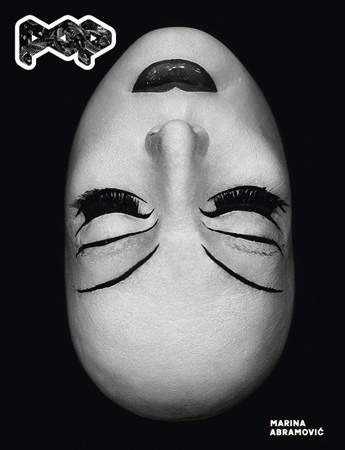
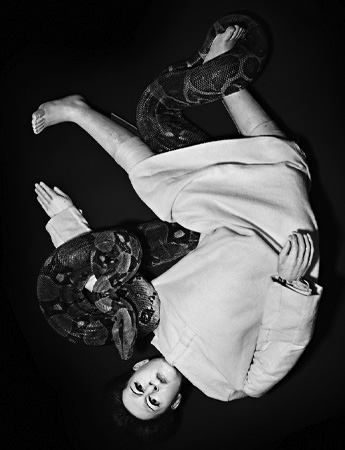 POP's Special edition Hardcover with Marina Abramović's death mask and "mini-me" wrestling with Daisy.
Photography by René Habermacher
POP's Special edition Hardcover with Marina Abramović's death mask and "mini-me" wrestling with Daisy.
Photography by René HabermacherMARINA CREDITS: Styling Isabelle Kountoure , Hair by Chi Wong at Julian Watson Agency using Shu Uemura Art of Hair, Make-up Yannis Siskos at Effex using Giorgio Armani Cosmetics, Photography Assistance Jonathan Flanders & Hannan Jones, Digital Remastering The Stimuleye, Snake Wrangler David Steward for Creature Feature, Production Lynsey Peisinger for The Stimuleye
FREJA CREDITS: Styling Isabelle Kountoure, Hair Peter Gray at The Collective using Shu Uemura Art of Hair, Make up Romy Soleimani at Management Artists, Manicure Tracelee Percival at Vue using Priti NYC, Model Freja Beha Erichsen at IMG New York, Casting Angus Munro at AM Casting, Streeters NY, Photography Assistance Cesar Rebollar, Fashion Assistance Jodie Latham, Stephanie Waknine, Rebecca Sammon & Michaela Dosamantes, Digital Technician Dilek Islidak, Digital Remastering The Stimuleye, Set Design Anne Koch at CLM NY, Production John Engstrom at Scheimpflüg Digital, Shot at Eagles Nest Daylight Studios NYC
-

Life and Death of Marina Abramovic – vii
-“An artist should avoid going to the studio every day”
STUDIO
Last night was the last performance in Manchester.Everyone in the cast and crew will soon be returning to their “normal” life, wherever it may be around the globe, to their city, their apartment, their studio.
Over the last week, seven exhausting nights, the play is ending.
It has been seen by Viktor & Rolf, Riccardo Tisci, the director of the MoMA and many others.But fear not, it will return, soon, somewhere else around the globe.
-

life and death of marina abramovic – vi
-Marina's 6th commandment. Photo by René Habermacher.
DICK
This is not a dick.
It’s a strap-on.
It’s strapped on a man, Andy.In the play, Andy masturbates while wearing a mask of Marina, as she flirts with him.
Tonight is the last night to see this, as it is the last night the play is performed in Manchester.
-

LIFE AND DEATH OF MARINA ABRAMOVIC – V
-“An artist should stay for long periods of time at exploding volcanoes”

Marina's fifth commandment. Photo by René Habermacher.
THE WIG
This is the wig of Willem Dafoe when it’s not on Willem Dafoe.
It’s in the make up room.In the play, Willem appears as a demonic, cartoonish narrator, meticulously going through Marina’s life chronologically, year after year.
-

LIFE AND DEATH OF MARINA ABRAMOVIC – IV
-“Enemies are very important”
Marina's fourth commandment. Photo by René Habermacher.
THE SNAKE
After an energetic premiere, the play keeps running until the 16th.One of the cast we havent yet introduced is Daisy, the boa constrictor.
Like bruno’s predecessor was stiffy, Daisy replaced the rolled-up blanket used for rehearsals.She naps in her well temperated box towards the minutes of spotlight.
It was difficult to find a hotel for her, says David the “snake-man”, so many houses had refused them shelter…Daisy and David. Photo by René Habermacher.
-

-

LIFE AND DEATH OF MARINA ABRAMOVIC – LAST REHEARSAL
-Marina, Willem, Bob, Carlos and the Serbian girls.
Only a few more hours left to marinate, before the feast.The stage doors. The note is to be taken very serious. Photography by René Habermacher.
Today Marina had her shaman coming from Santa Fe, New Mexico, in order to clear any bad spirits in the theater.
Magick is in the air, the mood has eased the morning following the preview.
Some eruptions excluded.Willem Dafoe noting remarks on his text. Photography by René Habermacher.
Preparations in the Make up rooms. Photography by René Habermacher.
After all, the puzzle of endless rehearsed scenes makes sense now, its emotional power in effect to captivate both spectators and cast.
As the premiere nears, the ticket office and press department whirl faster.
During breaks, we hear big names to will attend.
They have to be seated the right way. Tickets are limited and getting sparse.Carlos Soto. Photography by René Habermacher
Marina Abramović and Antony Hegarty. Photography by René Habermacher.
The Serbian girls, that form the chorus with peasant songs, cook and cater everyone with traditional baked beans.
The longer they marinate, the better they are supposed to get. Though the longer you leave the beans to marinate, the higher the risk of having your portion snapped away – perhaps we should put name tags on the glasses in the backstage fridge?
Anyway, it’s all about MARINAting. The effect is, it melts on the tongue….
Marina riding on her wooden horse Bruno. Bruno is a darling, but not too comfortable... Photography by René Habermacher.
Svetlana sings the chorus while the soldiers shout parts of Marinas artist's manifesto. Photography by René Habermacher.
Life And Death Of Marina Abramovic
at Manchester International Festival
July 9 – 16, 2011. -

LIFE AND DEATH OF MARINA ABRAMOVIC – III
-“An artist should not make themselves into an idol”
Marina's commandment III. Photo by Lynsey Peisinger.
MINI-MARINA
Mini-Marina is a doll that wears Marina’s own, real hair.It just flew in from New York City.
The costume department is working on dressing Mini-Marina for the premiere…
Life And Death Of Marina Abramovic
at Manchester International Festival
July 9 – 16, 2011. -

LIFE AND DEATH OF MARINA ABRAMOVIC – II
-“An artist has to be aware of his own mortality”
Marina's Commandment II. Photo by Lynsey Peisinger.
MASK
Its raining in Manchester. Although sometimes not.The first preview went on stage under the roof of that building where his architect threw himself from his landmark tower to death.
Marina thinks there must be some energy left from this.At Marina’s funeral, who do you expect to see in the coffin? Marina, obviously. Since we have three people in both of Marina’s funeral scenes, they decided to make everyone wear “Marina masks” so that everyone would look like her.
We call them “Marina Death Masks”. They looked much more morbid before they put makeup on them…
-

LIFE AND DEATH OF MARINA ABRAMOVIC : GUNPLAY
-Four more days to go until the premiere. The rehearsals proceed until late at night with great concentration. After four weeks of work, the cast, creative team and crew are almost ready for the first preview tonight. Bob Wilson, Marina Abramovic, Willem Dafoe and Antony Hegarty. An ensemble this beautiful doesn’t happen very often, perhaps just once in a lifetime.
The premiere is just hours away. Bob is orchestrating his cast and crew and the multi chromatic illumination of the play. Antony continues to conduct the music, snapping the tempo for the band while singing on stage. Willem recites his text in an endless mantra, a flood of whispers. His face and body moving through their various expressions. There is tension under the roof of the Lyric Theatre at the Lowry in Manchester. There have been troubles and tears and there have been shiny moments of camaraderie and playfulness, all in an effort to tell you a story. The story of Marina’s life. It is a story that will carve out a space for her in your heart forever…
Now, we go into our last rehearsal before the preview. The vultures are flying, Marina is slipping into her red, feathered dress and Bob….well, Bob is setting light cues.
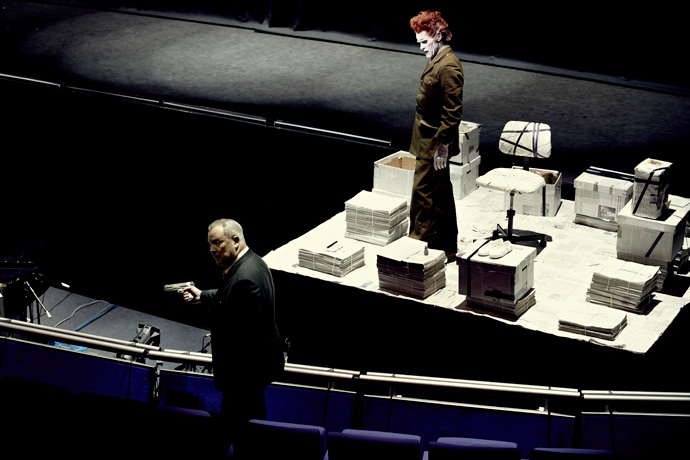 Robert Wilson instructs Wilem Dafoe in Gunplays. Photo by René Habermacher
Robert Wilson instructs Wilem Dafoe in Gunplays. Photo by René Habermacher
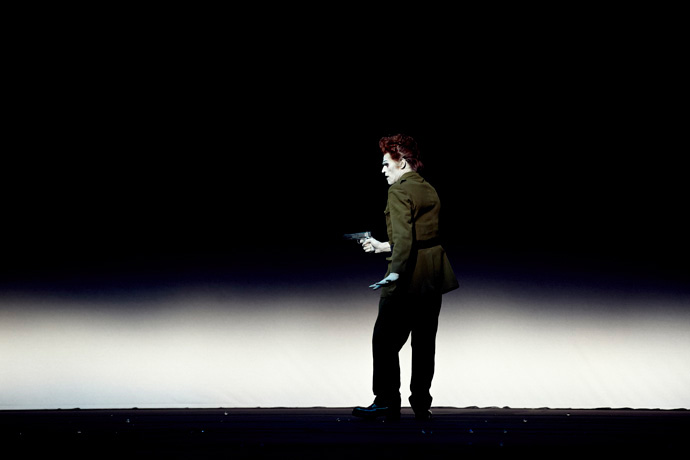 How Willem plays the gun. Photography by René Habermacher
How Willem plays the gun. Photography by René Habermacher
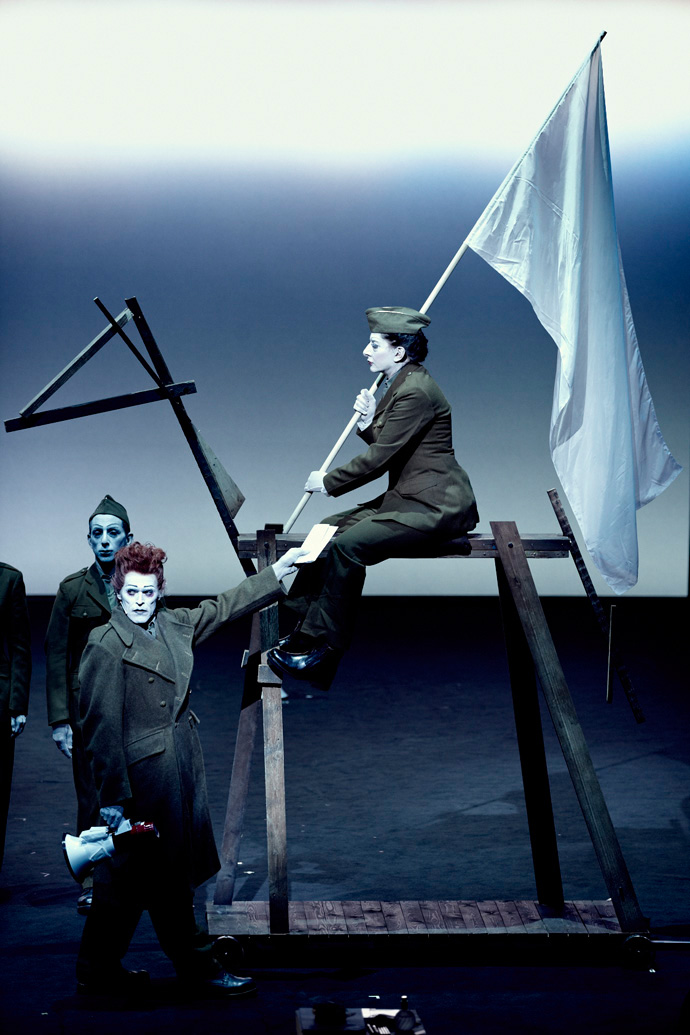 And finally on stage: "Bruno" as Marina calls him is the new Horse that replaces "Stiffy".
So here Bruno, Willem and Marina. Photography by René Habermacher
And finally on stage: "Bruno" as Marina calls him is the new Horse that replaces "Stiffy".
So here Bruno, Willem and Marina. Photography by René Habermacher -

LIFE AND DEATH OF MARINA ABRAMOVIC – I
-“An artist should have friends that lift their spirits”
Marina's commandment I . Picture by Lynsey Peisinger.
STIFFY
The first three weeks of rehearsals were held in a rehearsal space where we used temporary props and stand-in animals.Stiffy (aptly named by Willem Dafoe) was Marina’s stand in horse. We miss Stiffy now that we are at the theatre and the “real” horse has arrived.
He had a very wide body and Marina had to walk like a cowboy after sitting on him for too long.
But he was good to Marina for those weeks.Life And Death Of Marina Abramovic
at Manchester International Festival
July 9 – 16, 2011. -

ANNOUNCING THE LIFE AND DEATH OF MARINA ABRAMOVIC – MIF DAILY DIARY
-The Stimuleye is proud to be announce the upcoming series “The Life and Death of Marina Abramovitch” – MIF Daily Diary.
Under the direction of Robert Wilson, and with the participation of Antony Hegarty, Willem Dafoe and, of course, Marina Abramovic, this exceptional performance will run July 9 to 16, 2011 at Manchester International Festival, but you’ll be able to follow all the preparations right here, on the The Stimuleye.
Stay tuned…
Willem Dafoe, Marina Abramovic, Antony Hegarty and Robert Wilson. Photo by Antony Crook.
Life And Death Of Marina Abramovic
at Manchester International Festival
July 9 – 16, 2011. -

ATHI-PATRA RUGA: tales of bugchasers, watussi faghags and the afro-womble
-The ascension of young South African artist Athi-Patra Ruga came fast under radar of International attention.
His work, that is often characterized by a dislocated humor, is transcending the divides between fashion, performance and photography and interrogates the body in relation to society, ideology and politics, subverting the western ‘art library’ as he calls it.
The Stimuleye talks to charming Athi-Patra, who was recently featured in the Phaidon book ‘Younger Than Jesus’, a directory of the world’s best artists under the age of 33, about his work and influences.
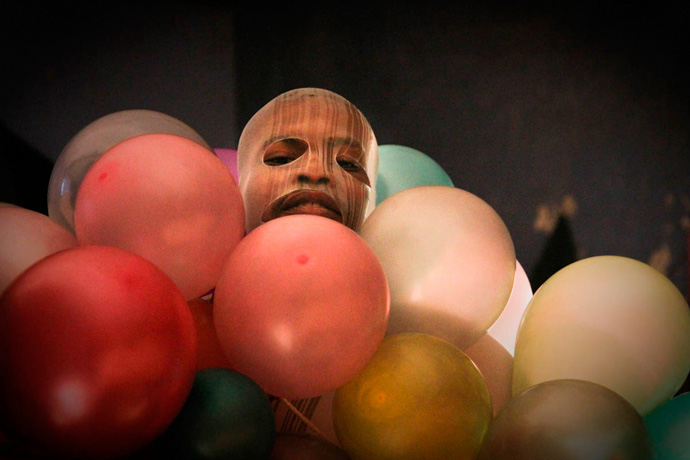 Athi Patra Ruga’s intervention for the X-Homes Hillbrow project with the character of ILUWANE.
Photography by Nadine Hutton
Athi Patra Ruga’s intervention for the X-Homes Hillbrow project with the character of ILUWANE.
Photography by Nadine HuttonRENÉ HABERMACHER: Where are you right now?
ATHI-PATRA RUGA: I’m in my Cape Town studio editing my latest tapestry series and fighting my cats… simultaneously. [laughs] I’m big on cat competitions… my two Russian blues Azange and Shadofax will be taking part so we have been grooming them like crazy… with a few scratches to prove it… hehe.
You’ve just came back from a break – have you got an idea already on what to work on?
At the moment I will be spending the next year creating quietly an extensive body of work revolving around a series of portraits that I will be rendering in tapestry. I have been doing a lot of sittings with various people and doing preliminary sketches. I am editing those now to get started in the next month. I was thinking of titles to name this body or the final exhibition etc: What do you think of :…the do’s and dont’s of bodyworship [laughs]
I am very interested in the power-relations involved in portraiture… especially in response to the ethnographic history involved. I am always concerned with who or what element in the image takes more precedents/importance… the technique or the seater or the artists ego. That argument in my head leads to some lovely renderings.
Your work is known to straddle the divides between fashion, performance and many more disciplines. What is your ultimate goal?
Transcending all boundaries that have been put on who and what one should create.
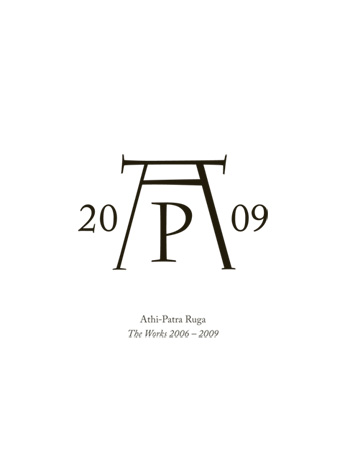
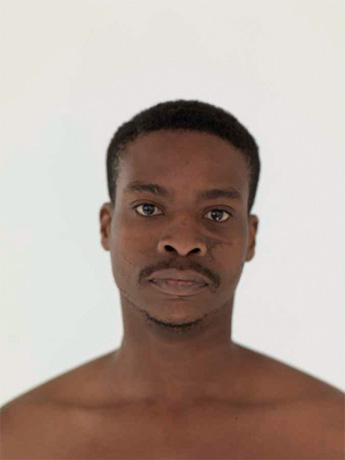 Athi-Patra Ruga's monogram and portrait photographed by Ant Strack
Athi-Patra Ruga's monogram and portrait photographed by Ant StrackThe monogram you use ‘AP’, seems to be derived from Albrecht Dürer?
Nice spotting, yes Dürer is the reference. A big part of the work is appropriation and ultimately subverting the “western art library”. In this case I am always interested in this “I am the one and only”, self-centric way of creating or rather I am totally disturbed by it. The logo is for Athi-Patra Ruga and studios cc. The name of my company and studio. The “and studio” part alludes to the idea that collaboration forms a big part of my practice. I would like to continue with this point.
Does Athi-Patra mean anything specific?
No, it’s a brand like others. And a brand is the highest promise of good quality and superior concept.
It’s two nicknames of my birth name. I’ve been called those names all my life really. It’s as old as I can remember.
So where does the “evil little boy”, as you called yourself come from?
Well I don’t know… I embrace my evils and vices I suppose. As to where it comes from, let’s just say there are a lot of boys and girls think so… at some points I tend to believe it. [laughs]
I was born in a Bantustan, which is a puppet state created by the apartheid government, a dictatorship. In March 1984, on my 13th birthday, Biggie Smalls died. My mom was a midwife, my dad a sports journalist. My parents were gone for long stretches of time and I had to defend myself. It seemed natural, it was one big ball of trauma. I grew up in the townships and during the strikes and boycotts. Many kids [or rather young adults] used to brutalise us for going to suburban/private schools. I spent most of my time indoors as many kids could not cope with me: I was violent in a violent time. Both at home and outside, the country was going through a revolution.
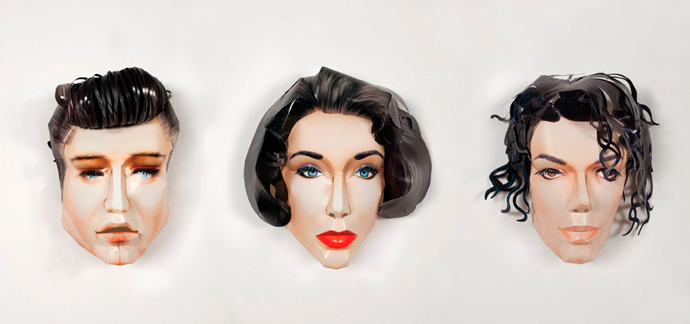 Athi-Patra Ruga: "Idol Death Mask Series" 2009, Modeled Paper, Approx. 27cm x 23cm each
Image courtesy of the artist and whatiftheworld gallery
Athi-Patra Ruga: "Idol Death Mask Series" 2009, Modeled Paper, Approx. 27cm x 23cm each
Image courtesy of the artist and whatiftheworld gallery -

NJA MAHDAOUI: strokes of liberation
-Nja Mahdaoui is one of the most celebrated living contemporary artists in the arab world. His bold and highly rhythmic work, derived from the arabic letter, is internationally renowned and can be found in ther permanent collections of the Institut du Monde Arabe, The British Museum and The Smithsonian Institution just to name a few.
It’s an exuberance of arabesque forms, a visual melody played out of his hand, that remind us of the great gestural and physical richness of action painting. Famous for his meticulous inks on parchment, this “liberated calligraphy” is worked across a variety of extremely different surfaces — from canvas, brass, wood, melamine and papyrus to skin. Though It seems like writing, it is not. It is rather an interlacing of a dialectic relationship, also found within Western abstraction.
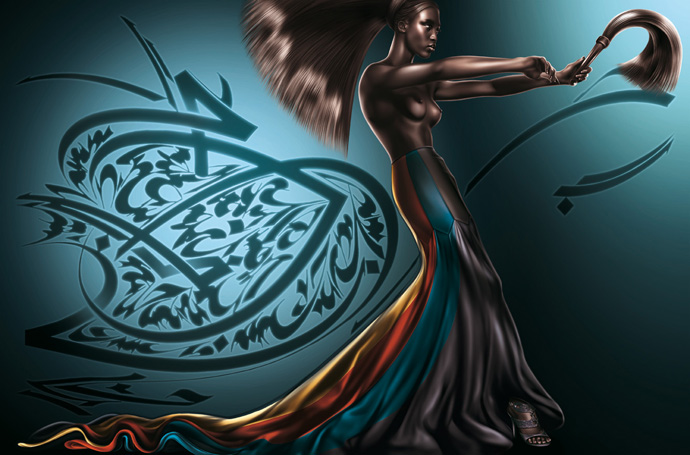 Naomi Campbell in Azzedine Alaïa for Numéro Magazine. A collaboration between Nja Mahdaoui and René Habermacher
Naomi Campbell in Azzedine Alaïa for Numéro Magazine. A collaboration between Nja Mahdaoui and René HabermacherI came across the work of Nja Mahdaoui the first time, while researching calligraphic styles on a project for the French magazine Numéro on a piece about Azzedine Alaïa to which Babeth Djian incited me. The visual impact of Nja’s work struck me at first sight.
Slightly intimidated by the references of the rich body of his work, I first hesitated but then thought to give it a shot, and contacted him. To my surprise he answered me instantly by email, and called me shortly after. Our collaboration was set — and we created a story of imaginary movements around Naomi Campbell as a dark gazelle, in sheer and revealing Alaïa.
But I only met Nja Mahdaoui in person two summers ago in Tunis. It was an all-embracing, hot and sultry August day that lay heavy on the city, matching the emotional state of its people.
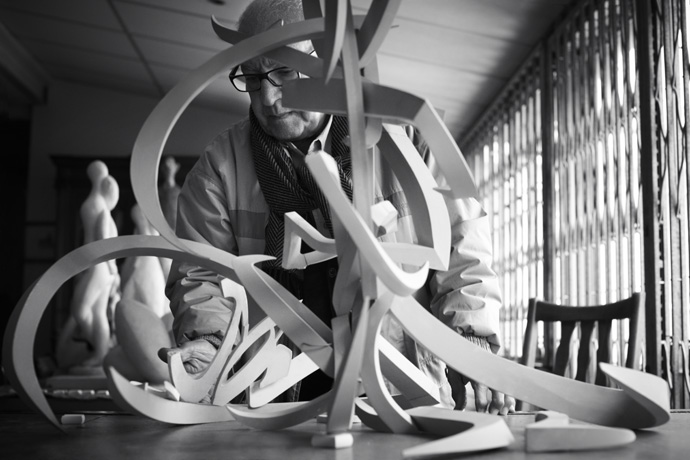 Nja Mahdaoui wit the first prototype of his most recent sculpture. Photography by René Habermacher
Nja Mahdaoui wit the first prototype of his most recent sculpture. Photography by René HabermacherA couple of months after the “Jasmine revolution” took place, Nja arrives in full swing to our meeting at a café in sunny, springtime Paris.
He’d come with his daughter Molka Mahdaoui to work on another of his new projects, yet is consumed with excitement by the events. He reacts immediately and impulsively to the question I usually ask last on conversations for The Stimuleye: What is the last thing that stimulated you?
“Stimulated? You’re asking a Tunisian? (laughs). I don’t know if ‘stimulated’ is the word, but it’s the explosion of a generation, I’m completely into it — for us it’s the event of the century!”
 Nja Mahdaoui: "Graphemes on Arches 2", 2009, Ink on arches paper; 135cm x 135cm.
Nja Mahdaoui: "Graphemes on Arches 2", 2009, Ink on arches paper; 135cm x 135cm.With us at the table are the collaborators involved in the process of making his latest project, a sculpture, the main reason for his trip north. Nja loves collaborations – his eyes glow while he talks energetically about upcoming projects. An energy I felt the first time I saw his bold and highly rhythmic work: “a dance of calligraphy”, with Nja as the choreographer of imaginary letters, to which he refers as ‘graphemes’, devoid of actual textual meaning:
“To a non-Arabic speaker it appears as coherent text. In fact even Arabic speakers assume at first that it’s a text with meaning. But when they start reading it they realise it is not an actual word.” he says and recalls an experience:
“It is not easy to write letters in a disjointed way — that is disjointed to not mean anything — and focus only on the aesthetic. There was a study at the California Institute of Technology in Pasadena. They connected me to a machine in order to test the levels of stress my body was under when I was writing proper words and when I was writing words without meaning. The study showed that my body was 2.5 times more stressed when I was working on words without meaning. So it is a very conscious attempt to create art. I tell people I’m not a calligrapher, but an artist.”
To me his body of work is so vibrant and remarkably innovative that I first had assumed Nja to be in his early 30’s the most, yet he was born in La Marsa, Tunisia, in 1937. As Molka, a filmmaker herself, puts it during our conversation: “sometimes i have to remind myself: Molka, you are thinking older than your own father!”.
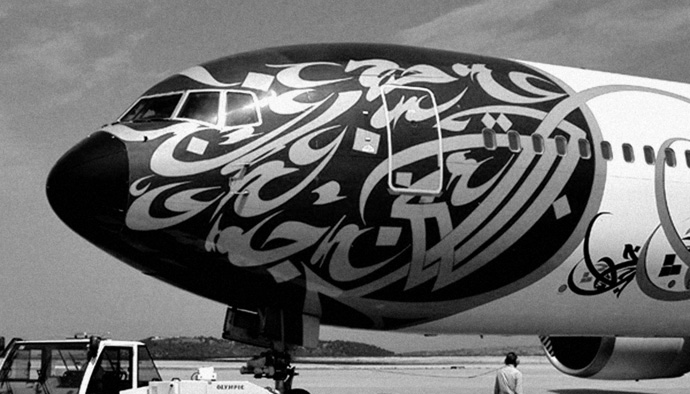 Nja Mahdaoui: Design for Gulf Air 50th Anniversary. Image Courtesy of Nja Mahdaoui
Nja Mahdaoui: Design for Gulf Air 50th Anniversary. Image Courtesy of Nja Mahdaoui -

Out of the box: LEIGH BOWERY
-The other day i was going through boxes of photographs between sheltering sheets of cellophane. I came across a reminiscence from a time when I was obsessed with polaroids: a series of shots that I had taken from artist Leigh Bowery, in what was probably one of his last performances in late May 1994.
Leigh Bowery performing at the RoXY Amsterdam on May 17 1994. Polaroid by René Habermacher.
It was a party at the legendary RoXY club Amsterdam, with Boy George and Robert Owens on the turntables and leading clubbers Sheila Tequila and Stella Stein appearing, to the bemusement of the crowd, nude with pubic wigs only.
That Night Leigh Bowery presented his classc “Birth Show” together with Nicola Bateman-Bowery, whom he had married just 3 days before.As usual for Leigh, the performance, an homage to John Waters “Female Trouble”, would attack the spectators sensitivities- which even worked for the notorious Roxy audience: Leigh would appear to enter the stage in what seemed a rather conservative flower dress to sing with his band Minty, but toward the middle of the song birthed his partner Nicola, who was held under his costume upside down using a specially-designed harness. Nicola then appeared as a very large baby covered in placenta.Leigh died later that year on New Year’s Eve from an AIDS-related illness. A death bed pronouncement by “Modern Art on legs”, as Boy George commented, was: “Tell them I’ve gone pig farming in Bolivia”.
Leigh Bowery and his wife Nicola Bateman-Bowery, then freshly wed. Polaroids by René Habermacher.
It was one of these Spectacles that made the RoXY’s infamous reputation. Not only a club, the RoXY was an Institution. A playground and battlefield for artists. While mingling among the glitterati and club kids of the time I recall seeing there first time the work of Inez Van Laamsweerde and Vinoodh Matadin on a flyer- or a toilet exhibition of Erwin Olafs photographs, an explicit series that was was by far outreached by what was going on in these restrooms…
Founder Pieter Giele’s Motto AB IGNE IGNEM CAPERE (one fire ignites another) came true some years later. The Club that operated from 1987 in a splendid old theatre on Prinsengracht went up in flames the day of Pieter Giele’s Funeral in 1999 and burned down to the ground.
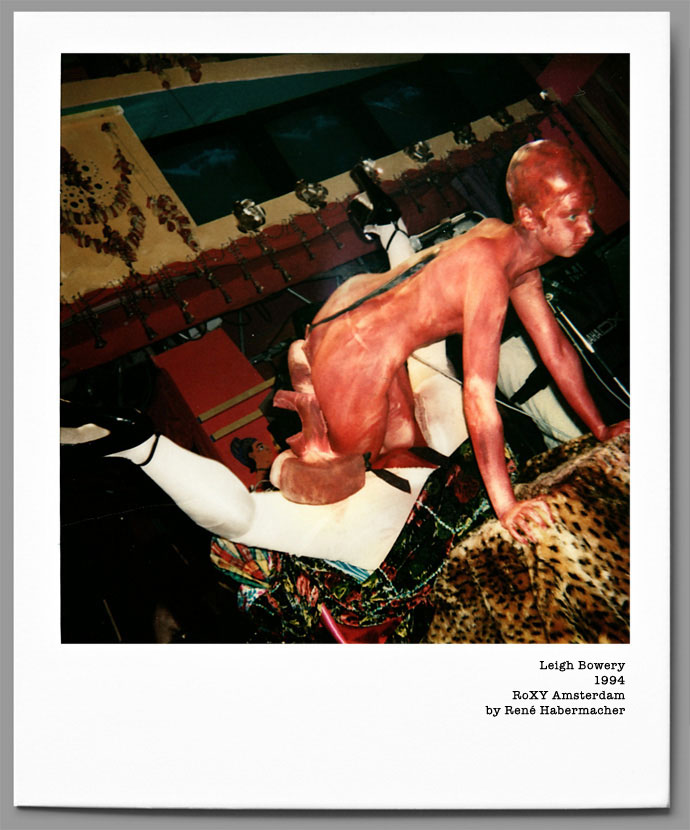
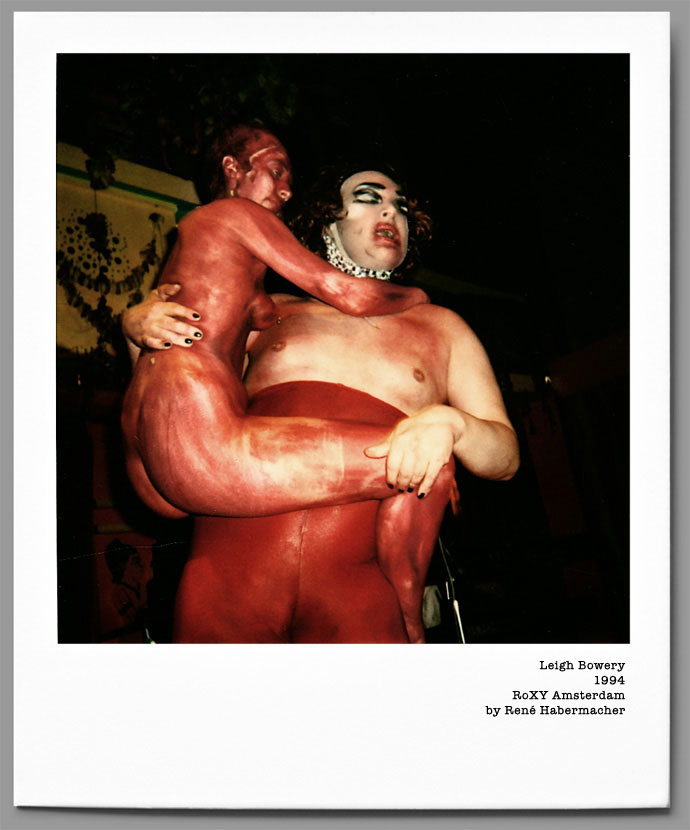
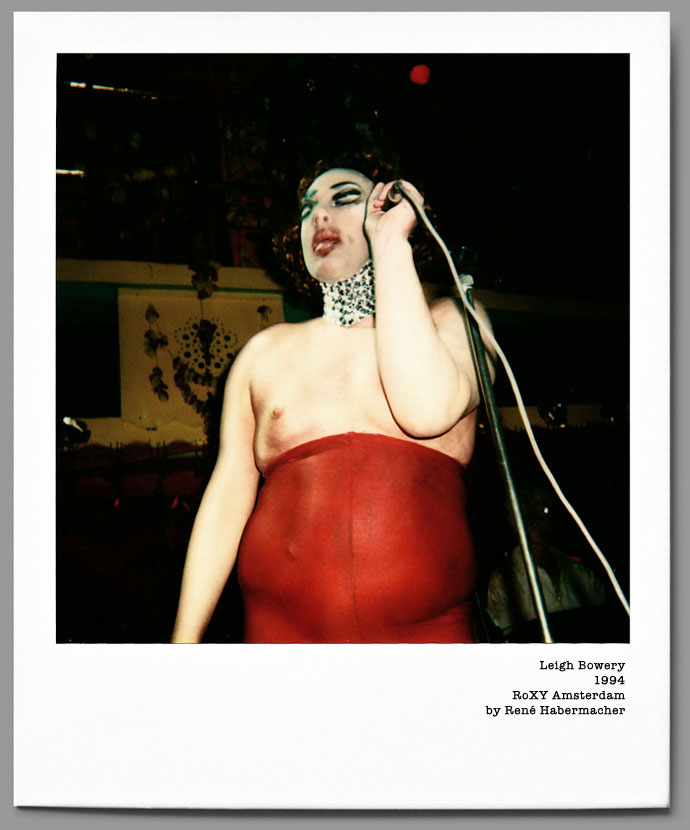
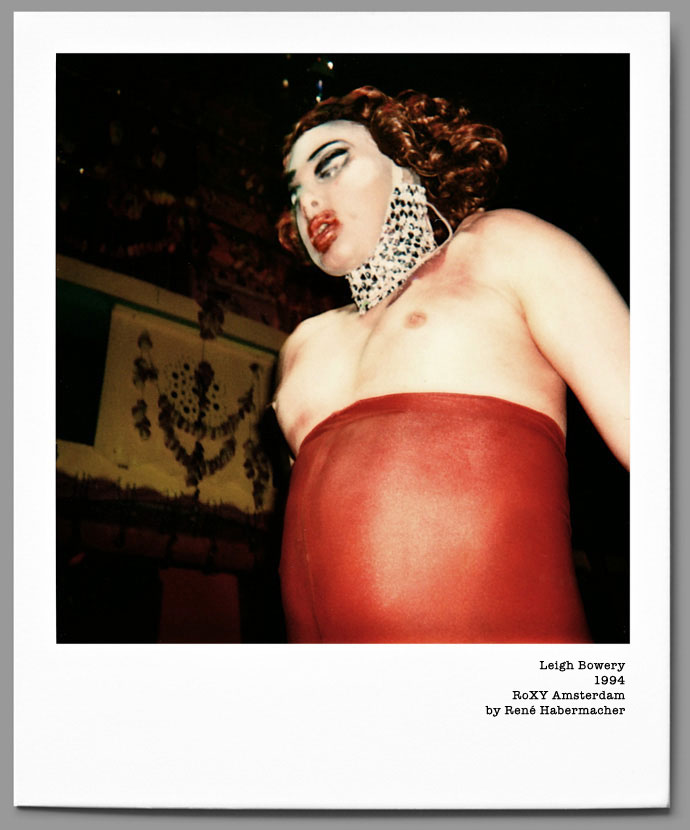
Leigh Bowery on stage with the MINTY. Polaroids by René Habermacher.An exhibition of photos by the club’s photographer Cleo Campert will be on show later this summer at the LUX Photo Gallery Amsterdam from 18 June – 18 July: The RoXY Years / De RoXY Jaren
Cleo Campert: “In this show I emphasize the open sexuality and the indecent exposure which reigned in the famous night club RoXY in Amsterdam in the early nineties.” -

dimitris papaioannou : spatial and human relationships
-SPATIAL AND HUMAN RELATIONSHIPS
Continuing the conversation with Greek choreographer Dimitris Papaioannou, this second part concentrates on his post olympic work as MEDEA2 and the influences of butoh and his native Athens in his work.
 Scene from MEDEA2 by Dimitris Papaioannou. Photo by René Habermacher
Scene from MEDEA2 by Dimitris Papaioannou. Photo by René HabermacherRENÉ HABERMACHER: Over the years your journey has brought your work to ever-larger audiences. Recently, with your play MEDEA2, you revisited the past. How was that experience?
DIMITRIS PAPAIOANNOU: It challenged me for a number of reasons. If you follow my journey, I was violently exposed to the general public with the success of the Opening Ceremony of the Athens Olympic Games. In order to recover from the experience, I had to take a two-year break.
The first thing I chose to do after this pause was a show called 2. 2 was actually an attempt to pick up where I had left off before the ceremony, to return to my roots and re-evaluate my work. I constructed a very personal show on a large scale because I was offered the opportunity to do so, and I tried to restart my interrupted line of development in an unusual way.
After this experience many question marks arose, and I realised that I was still exposed to a much larger public than I was used to. I had the feeling that there was a new kind of communication being created that was both charming and dangerous. I needed more time before taking my next step.
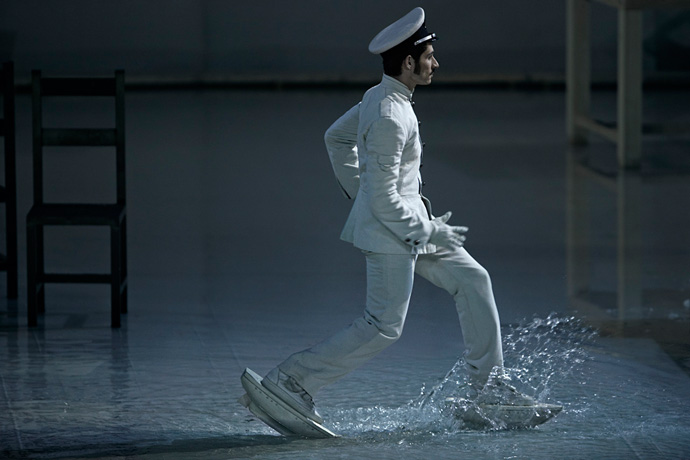 Jason crossing the sea. Scene from MEDEA2 by Dimitris Papaioannou. Photo by René Habermacher
Jason crossing the sea. Scene from MEDEA2 by Dimitris Papaioannou. Photo by René HabermacherMany people were suddenly exposed to my work through the Olympics, but of those who had a real interest, many were too young to have experienced MEDEA. So I returned to MEDEA, attracted by the idea of presenting it again with an all new cast, and approaching it with a new idea: to take the passion out. I wanted to reconstruct it, refine it, clear it out, strip it of anything unnecessary, drain the blood from the performance and deliver it in the cleanest form I could manage. That was my intention with MEDEA2.
Having done that, I could continue with new work, first NOWHERE and now INSIDE. This is a completely new phase, where I am tending to create shows with no protagonists and no characters. The crowd is the element I’m focusing on now, using it in a more open structure in order to create images involving spatial and human relationships.
Excerpts of MEDEA 2 accompanied by interview with Dimitris Papaioannou.
-

dimitris papaioannou : a pasolinian touch
-Dimitris Papaioannou’s work as a choreographer has significantly reshaped the Greek performing arts landscape.
With his directing of the Athens 2004 Olympic Games Ceremony, a ground-breaking success, he played his way straight in the heart of the spectators, hailed a “triumph” by TIME MAGAZINE and THE TIMES of LONDON.In 2005 Dimitris Papaioannou was awarded the Golden Cross of the Order of Honour by the President of the Hellenic Republic for outstanding artistic achievement. For his following shows “2″ and MEDEA2 enjoyed an unprecedented run in the Greek capital, each with over 100 000 tickets sold. This accelerated development came not without controversy. With his latest play INSIDE Dimitris returns to his experimental roots.
THE STIMULEYE met with him during a break of rehearsals in Athens, to speak about his new play and look back to his point of departure.
Following the first part of three on the conversation with Dimitris Papaioannou, accompanied with exclusive pictures by René Habermacher.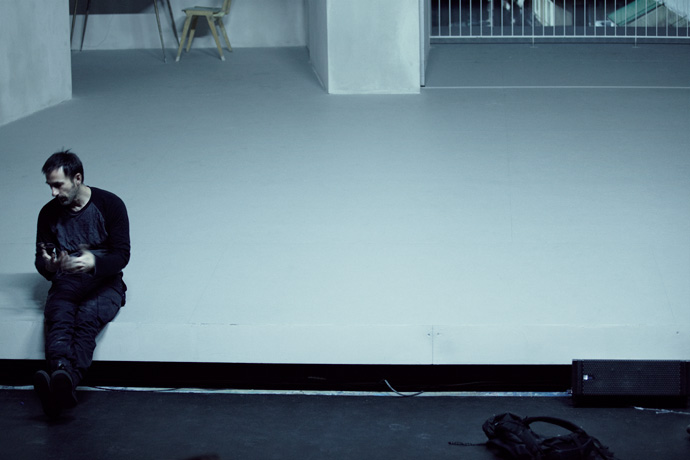 Dimitris Papaioannou on the rehearsal set for his new play INSIDE. Photo by René Habermacher
Dimitris Papaioannou on the rehearsal set for his new play INSIDE. Photo by René Habermacherpasolinian touch
DIMITRIS PAPAIOANNOU: I’ll be right with you — I’m just making a coffee!
RENÉ HABERMACHER: You’re freshly shaven! You look very 19th-century with your moustache.
I am from the 19th century honey, I’m very old!
It’s been a while since we had time for a talk, since I left Athens and you last visited Paris. We met only briefly during the rehearsals for your new play INSIDE, which you’re currently working on. You spent last Spring in New York. Tell me about what you did there.
I was there from March until June on a Fulbright Artist’s Scholarship. A mid-career scholarship obviously… [laughs]
Actually in a way I was studying the story of performance art [with Laurie Anderson at The Kitchen NYC] and developing my Final Cut Pro skills, as well as experiencing a little more of New York life, now that I’m a mature boy and things are different!
How was it returning to Athens after that?
For me it was a blessing because I discovered that I had left New York when I was still under construction. It’s the perfect place to be when you are like that, but in this phase of my life what I found there was a little more superficial than I would have liked. The Athens I returned to was in complete economic crisis and emotionally depressed, but still I was deeply relieved to spend summer back home.
Dimitris, I know you were born in Athens, but we’ve never talked about your childhood.
I was born and grew up in Athens, in a lower-middle class family. My parents made financial sacrifices so that I could go to a very expensive school, the Athens College. Then I had to run away from home because my parents wanted me to live the life of a straight architect. But I was a gay man, and I wanted to be a painter. I became the student of the Greek painter Yannis Tsarouchis* (1) in the old fashioned way, where painters trained people in their atelier. It was there I was introduced to true art. I had been painting since I was a child, but it was when I met Tsarouchis that I realised what painting really was. Later I entered the Athens School of Fine Arts.
* (1) : Yannis Tsarouchis, 1910-1989 One of the most important twentieth-century Greek painters, Yannis Tsarouchis portrayed and helped to define modern Greek identity. The deeply sensual painter was much influenced by the French impressionists and often depicted sailors, soldiers and the nude male body in erotic situations.
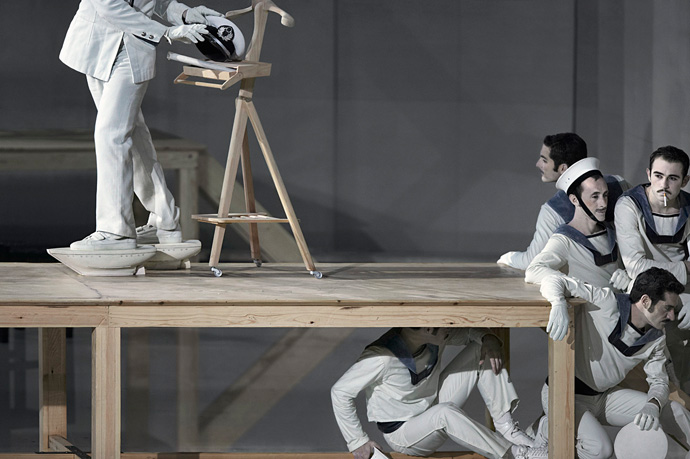 The departure of Jason in reference to Yannis Tsarouchis. Scene from MEDEA2 by Dimitris Papaioannou
The departure of Jason in reference to Yannis Tsarouchis. Scene from MEDEA2 by Dimitris PapaioannouHow did you meet Tsarouchis?
I knocked on his door. I showed him some my paintings and asked for his comments. He was not cruel, as he could have been, about those awkward early drawings — instead he was very polite. My college had organised an exhibition of my work in the building’s library, so I invited Tsarouchis to see my work up close. The next day he called me and invited me back to his house, after which he allowed me to watch him paint, and would give corrections on my paintings. I became his student.
How did this encounter shape you? Did it leave a mark on your artistic work?
Well, your first mentor leaves a strong mark on your life. I grew up in a house that had no contact with artists, there wasn’t a single painting on the walls. My parents weren’t very fond of art, it wasn’t part of their lives. I felt like an alien, wanting to enter this world. So Tsarouchis was the first artist I really saw working, and I realised that the life of an artist is possible and, to my eyes, very charming. I felt at home in a way. And he was a great painter. He had a quality that interests me a great deal: he could make magic with the humblest of materials — he could make roses out of toilet paper, use wires to make small sculptures. The thing I think I have learned from him is that you can make poetry out of garbage.
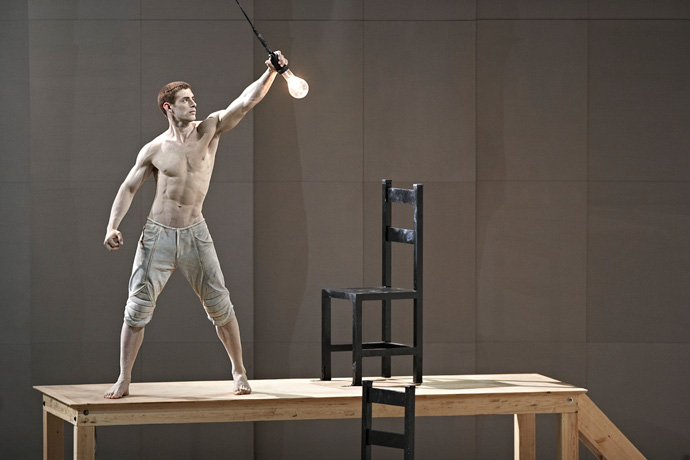 “Helios”. Scene from MEDEA2 by Dimitris Papaioannou. Photo by René Habermacher
“Helios”. Scene from MEDEA2 by Dimitris Papaioannou. Photo by René Habermacher
